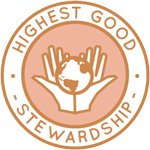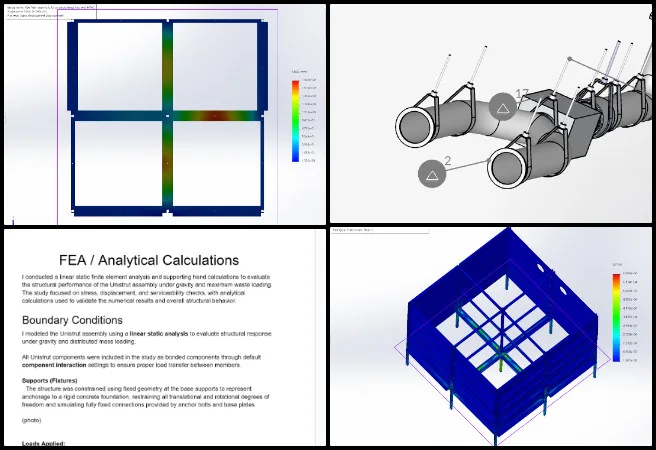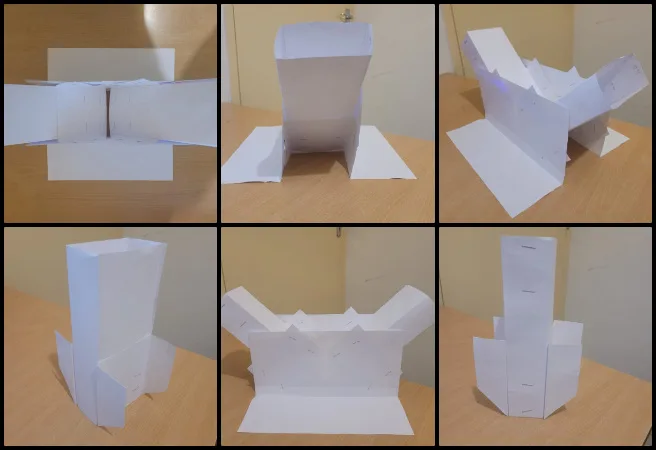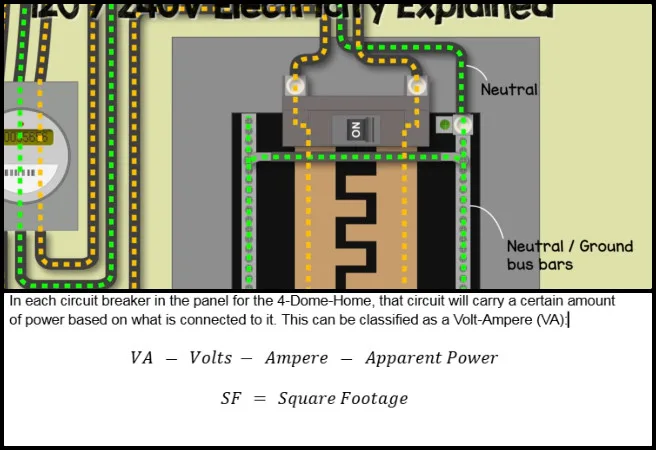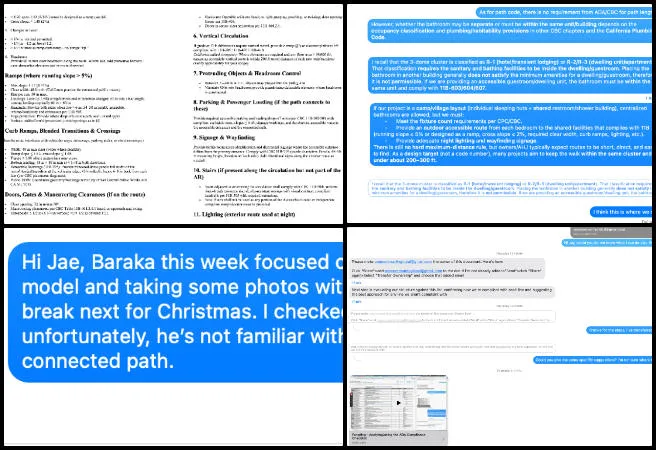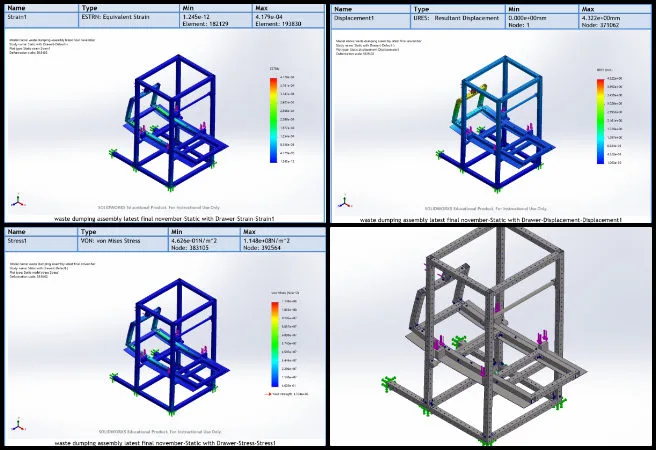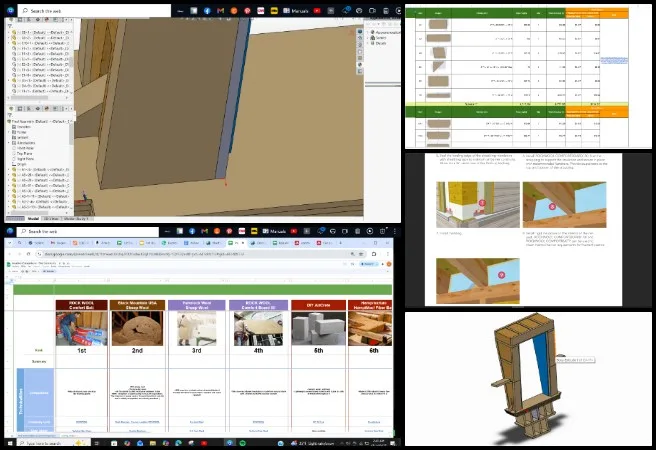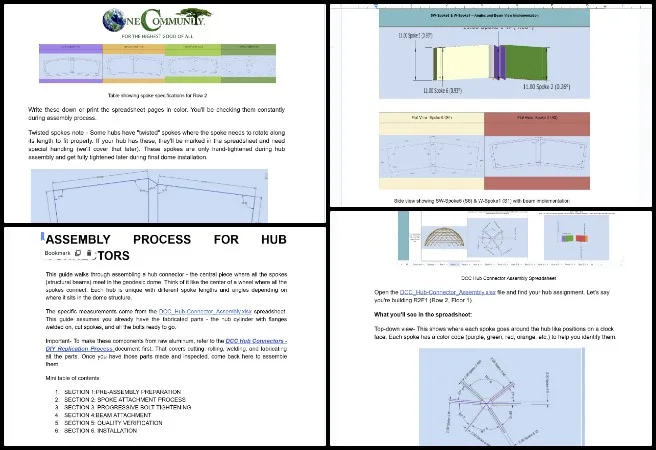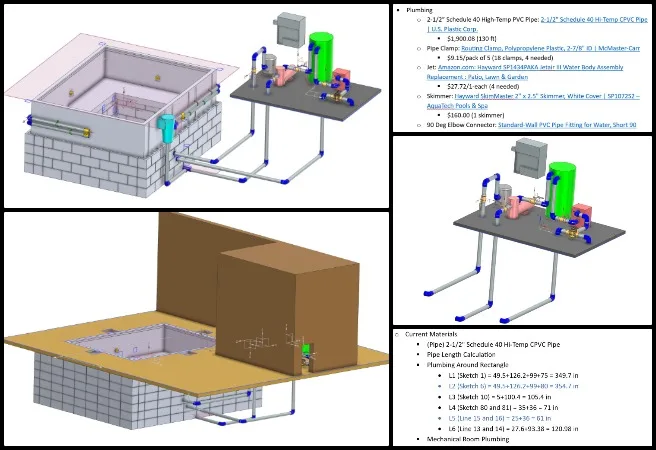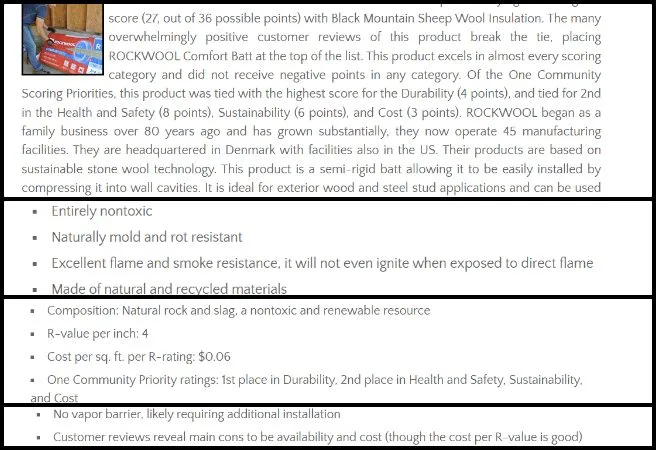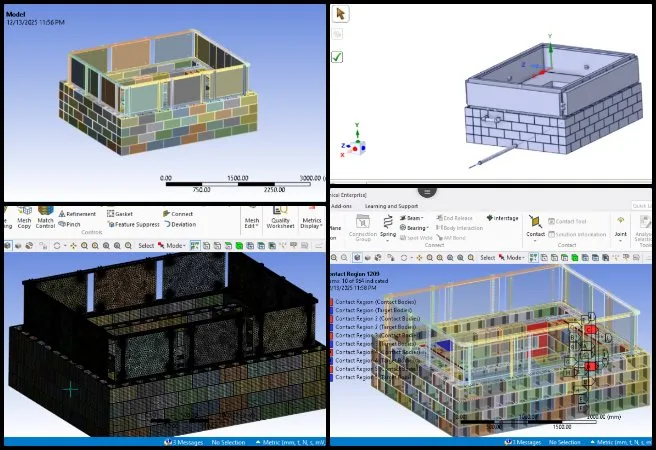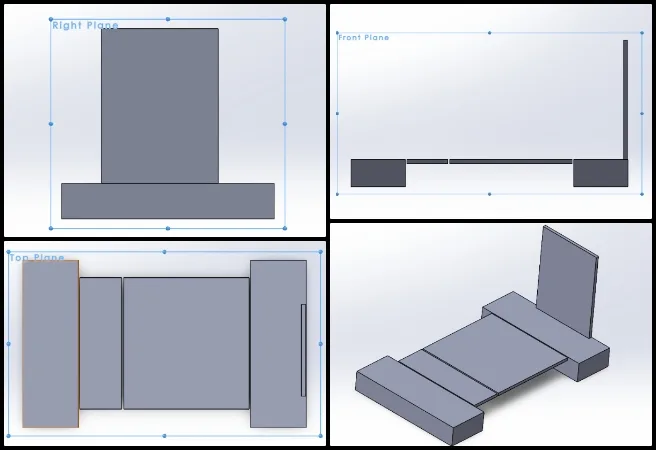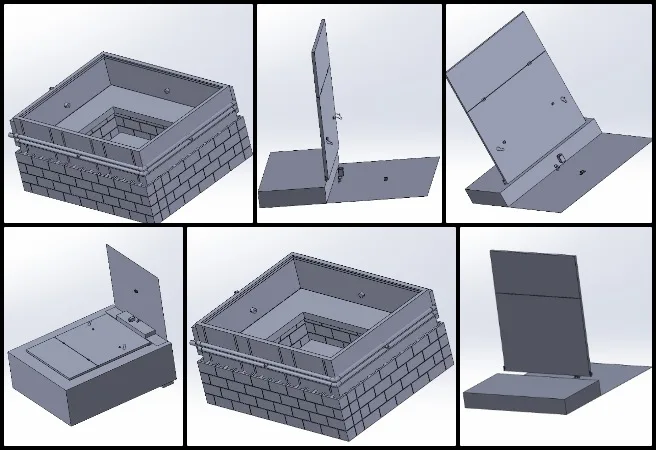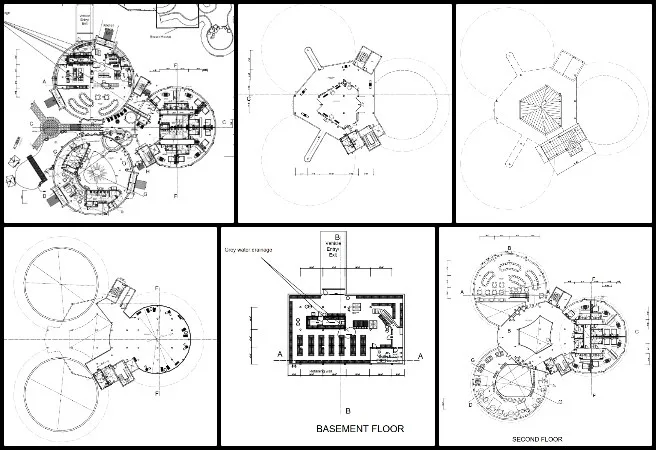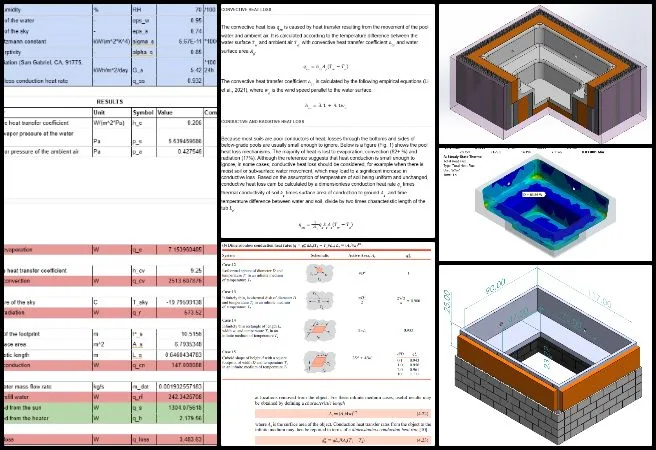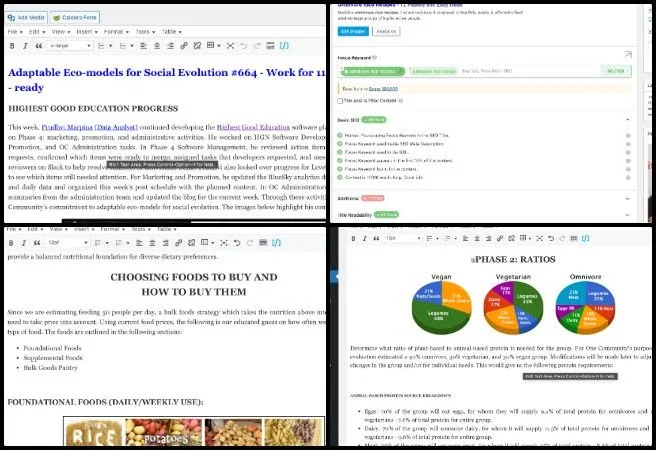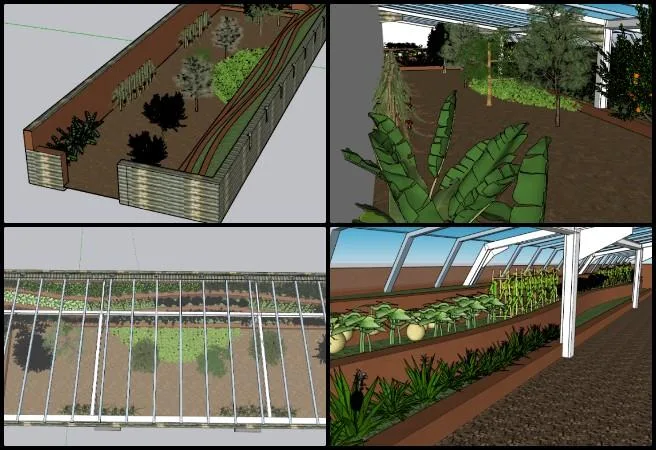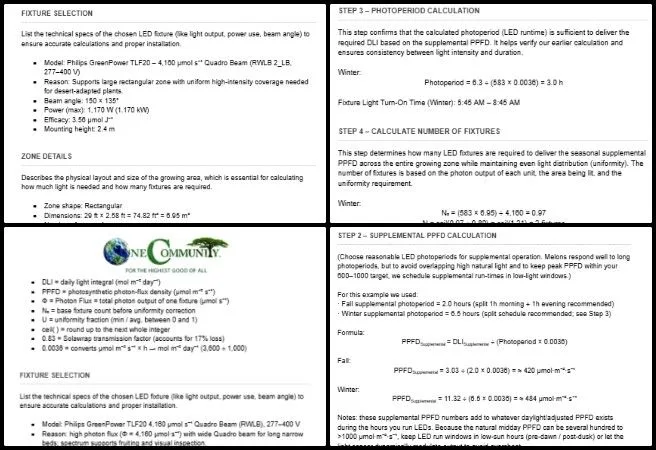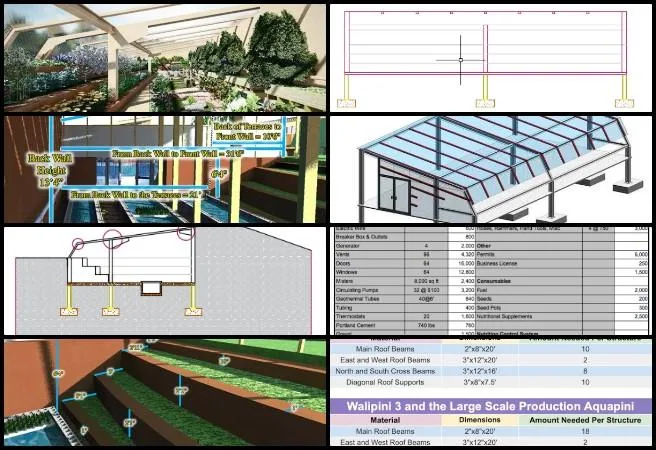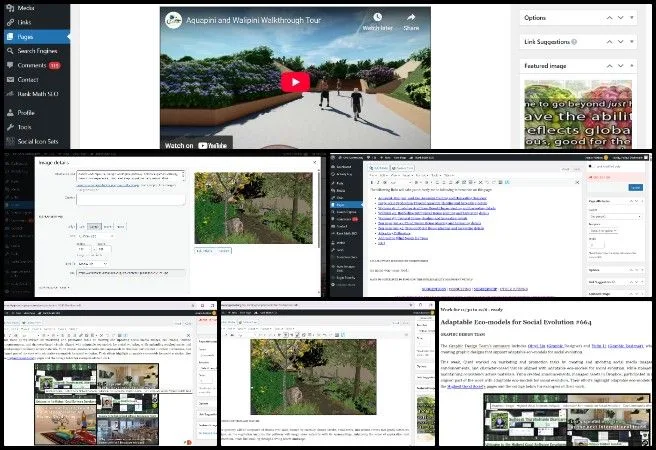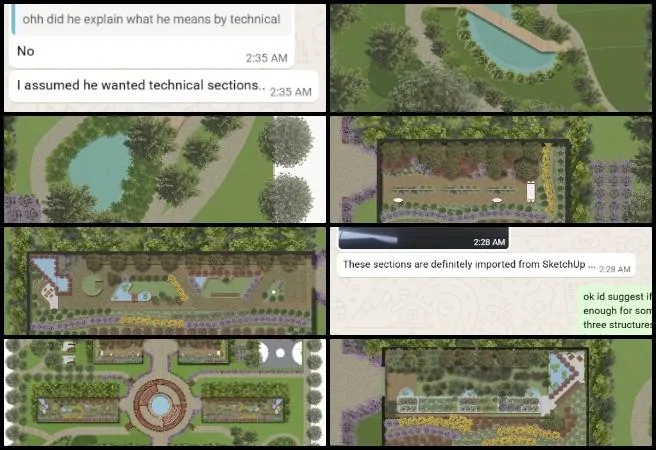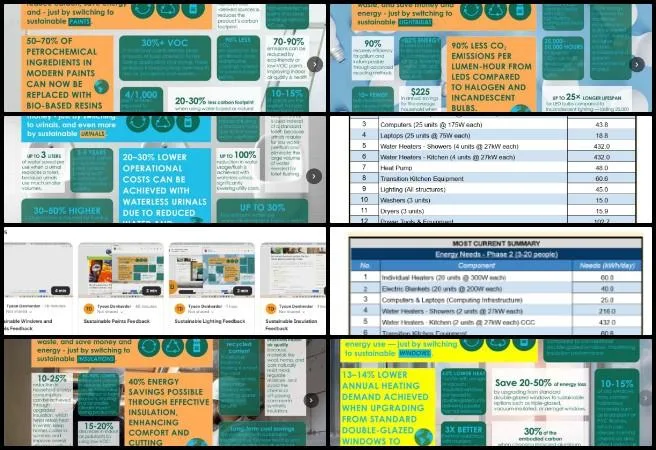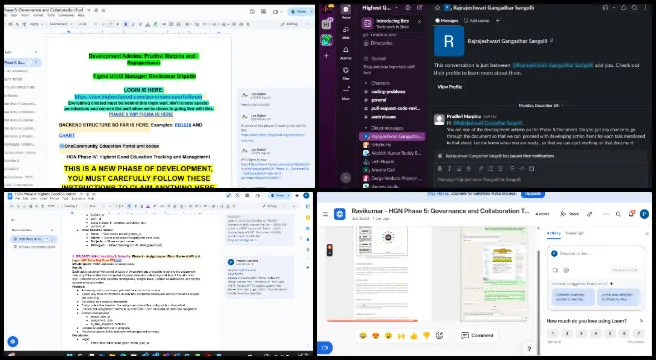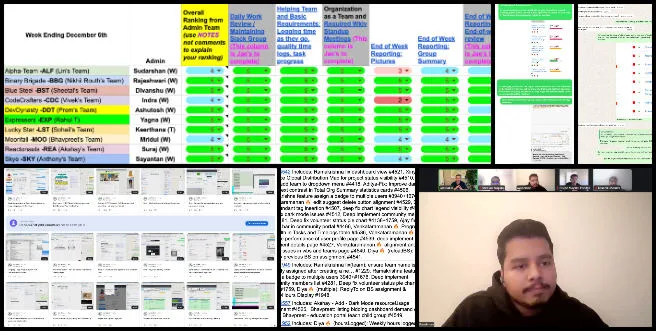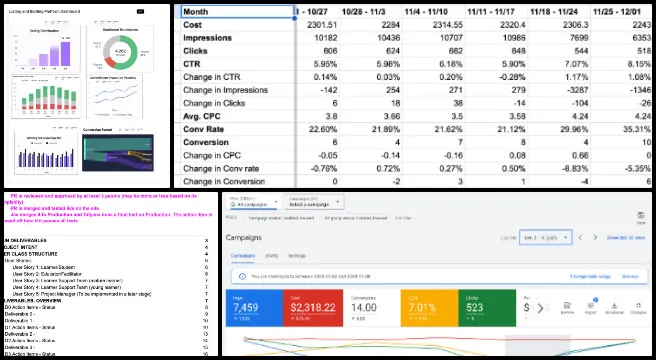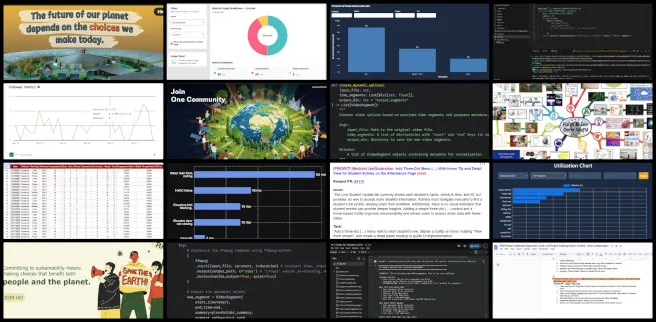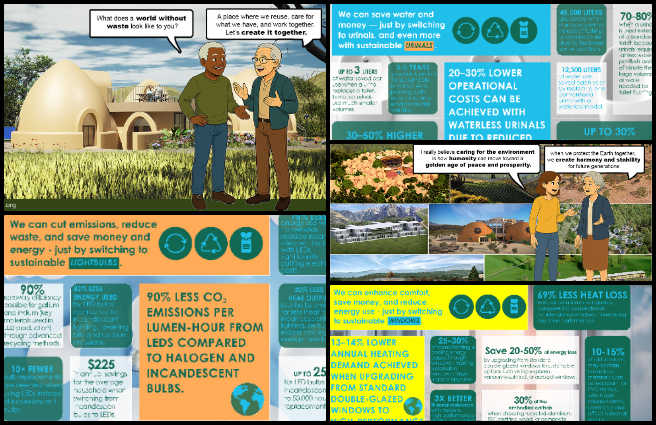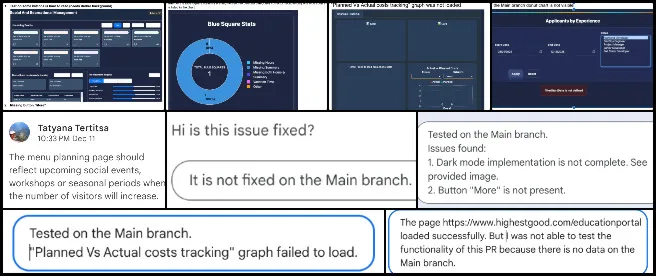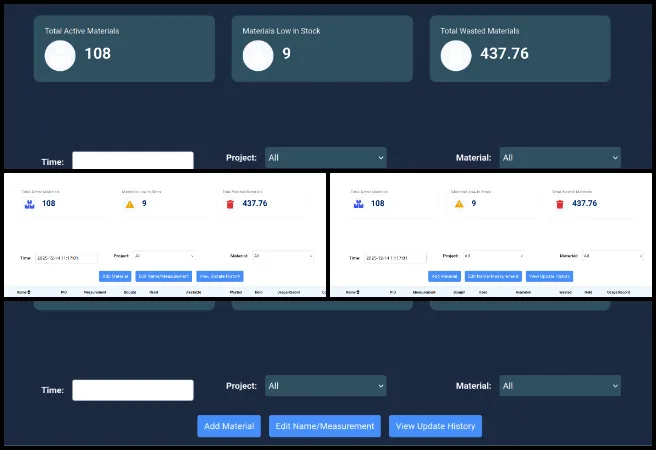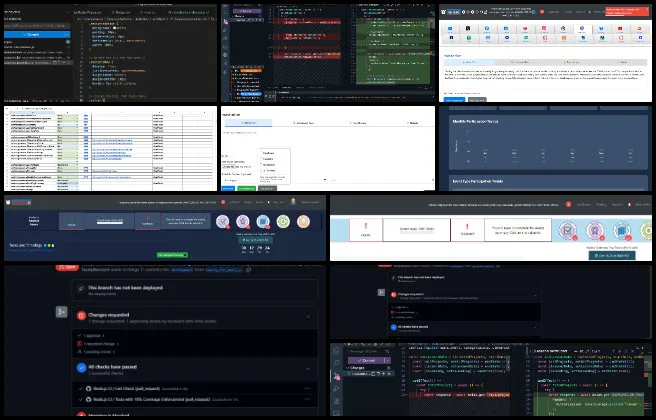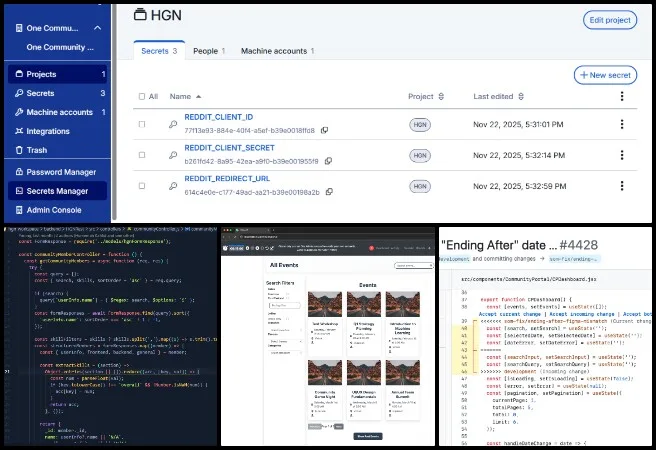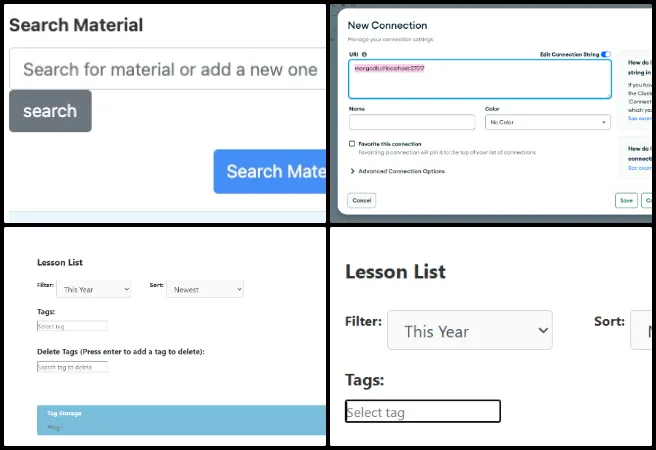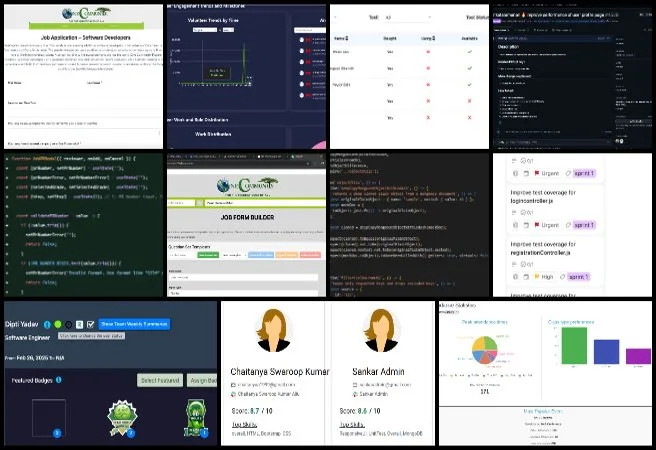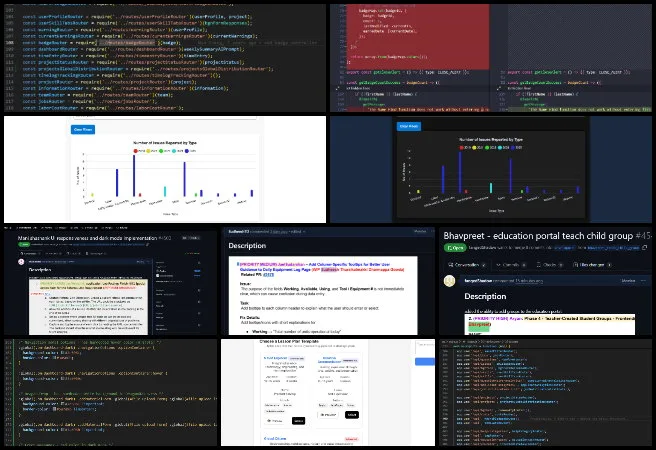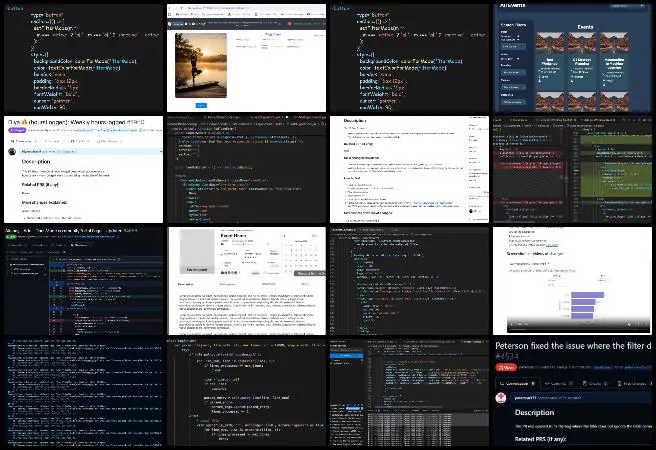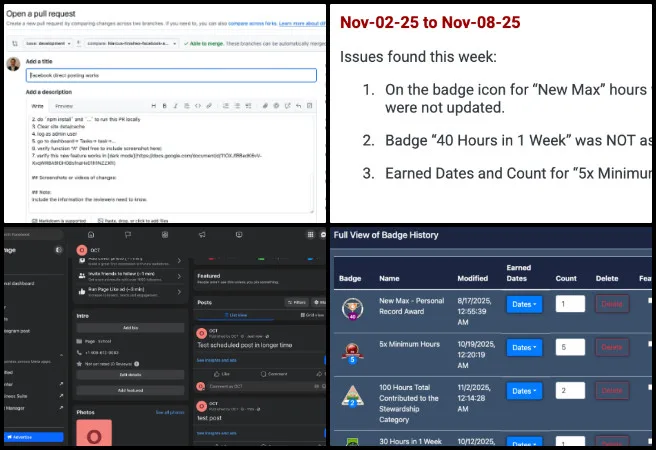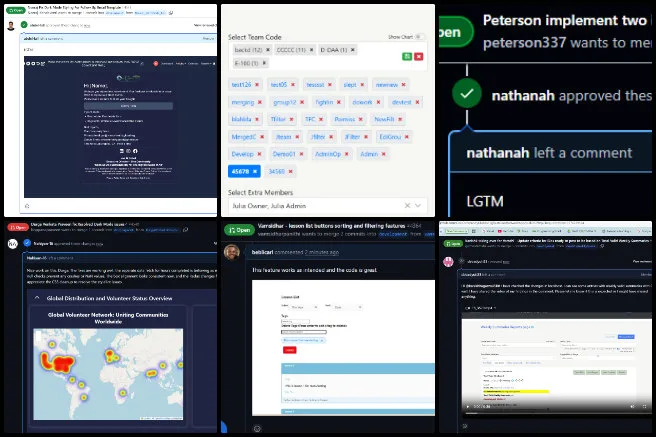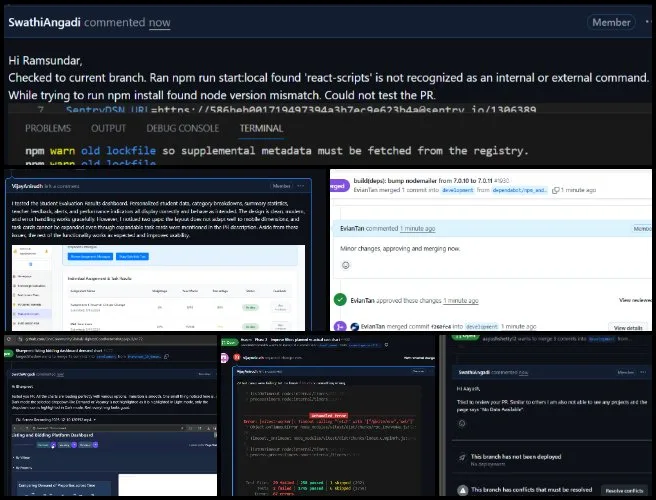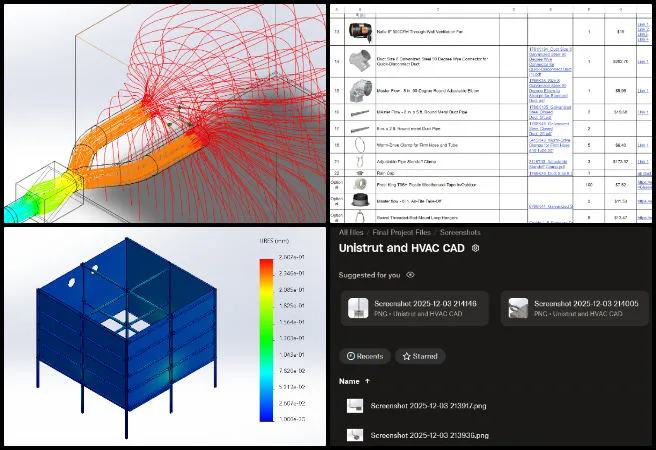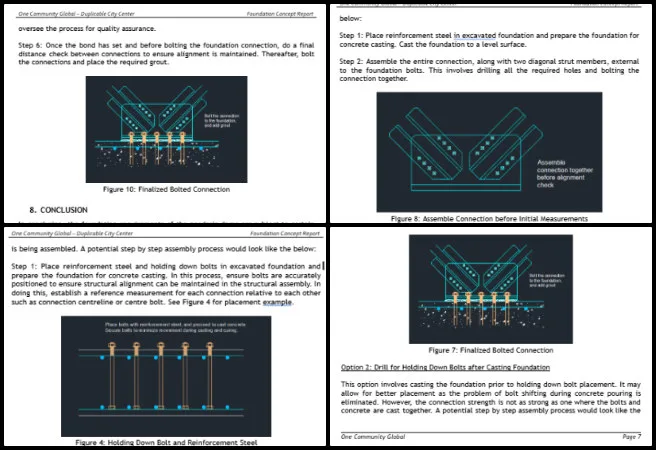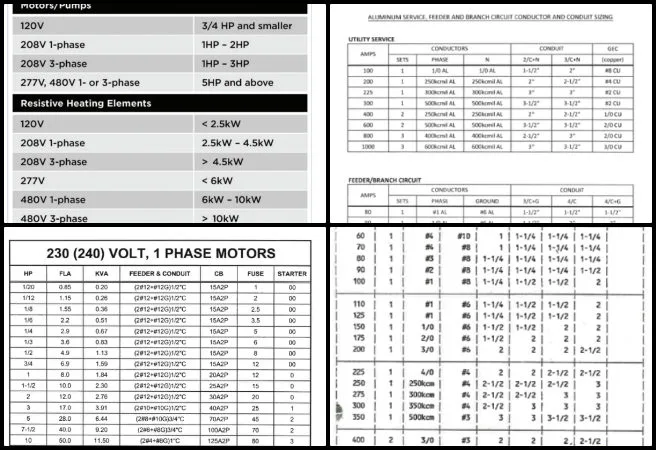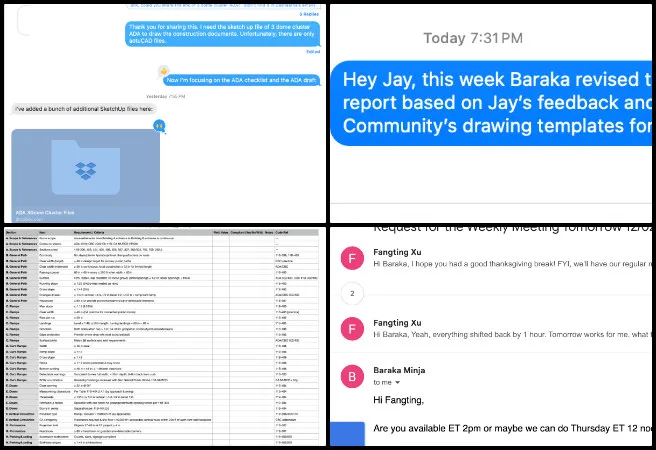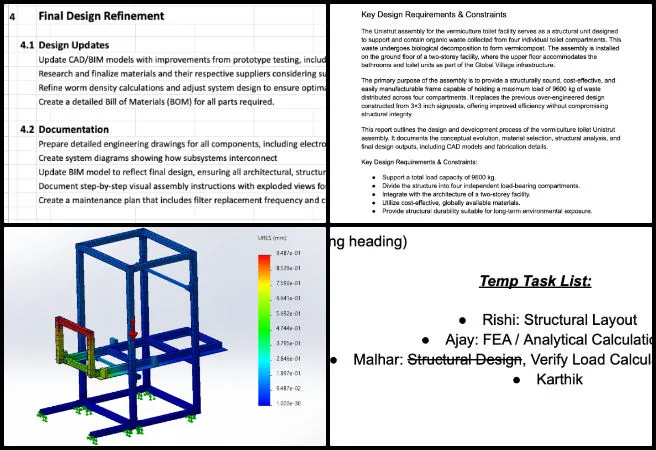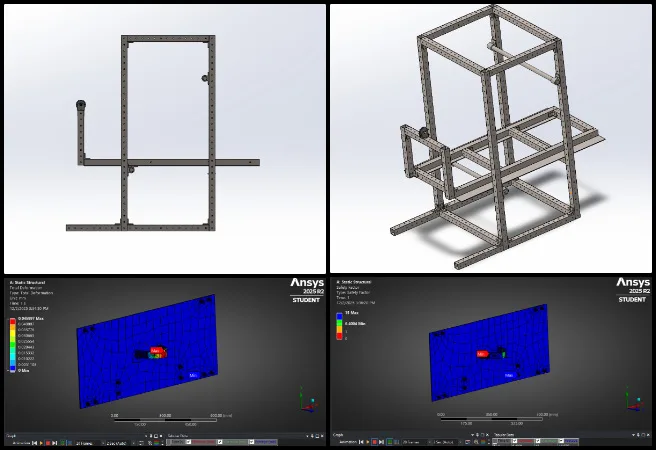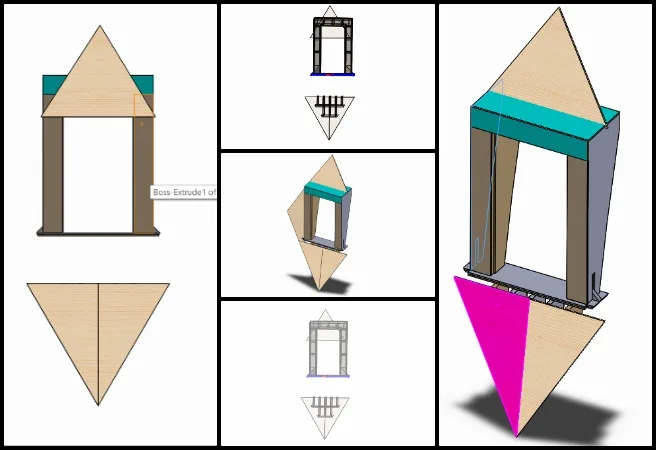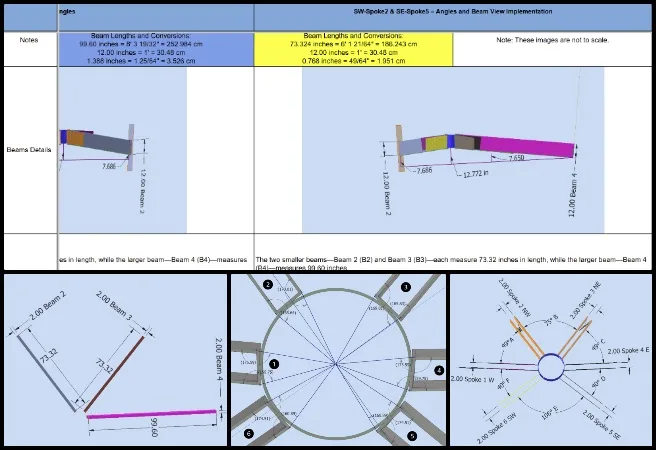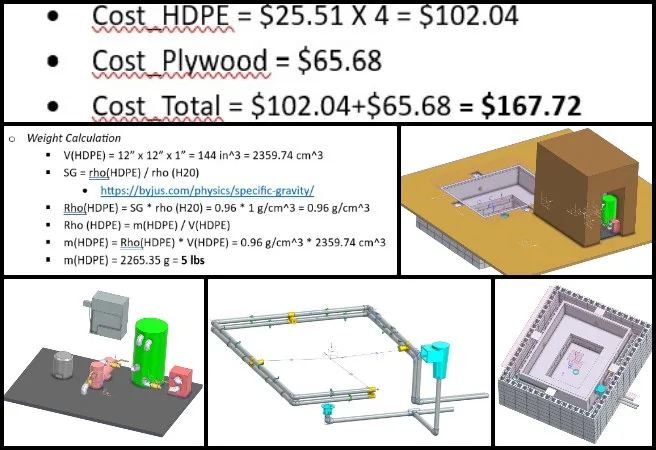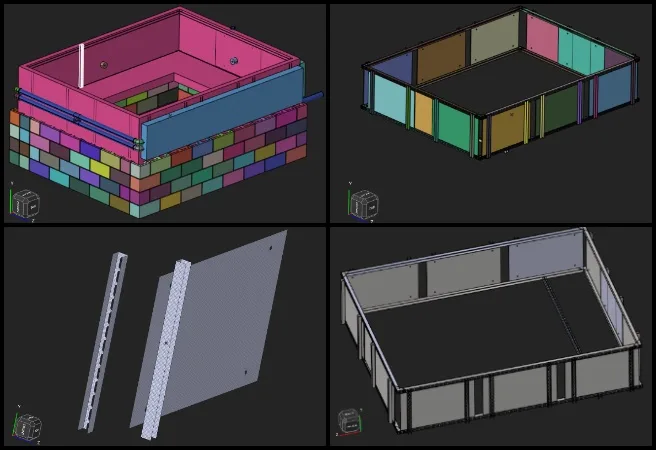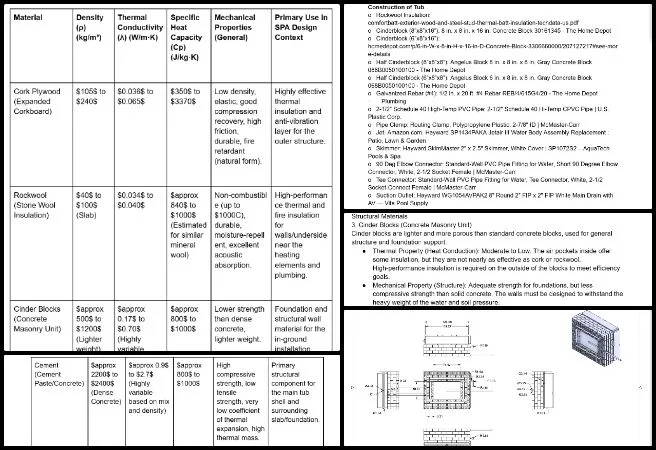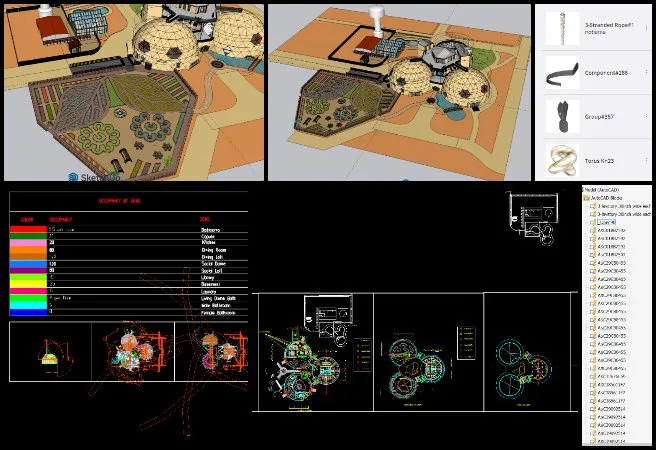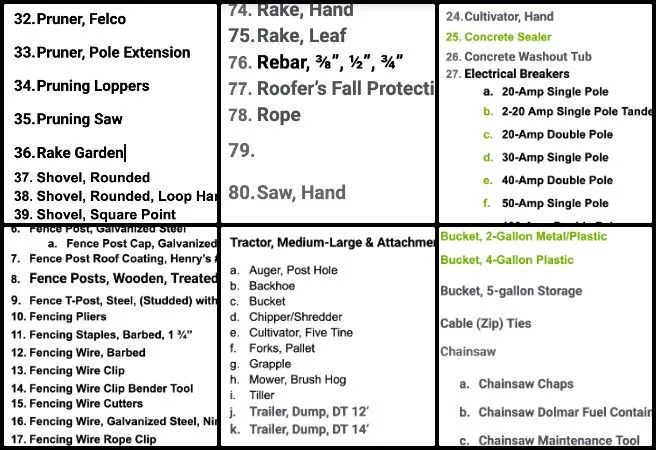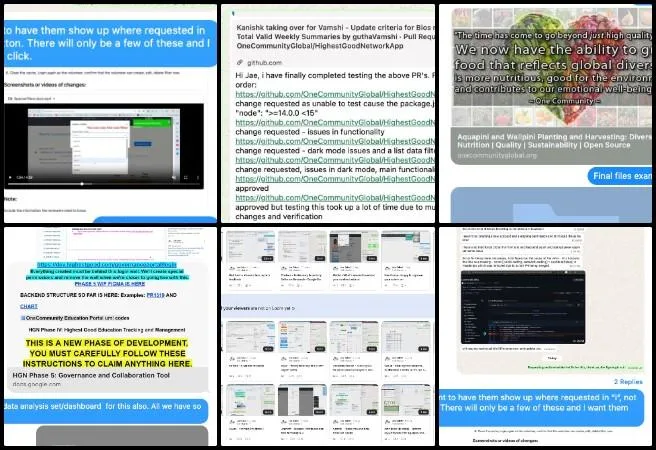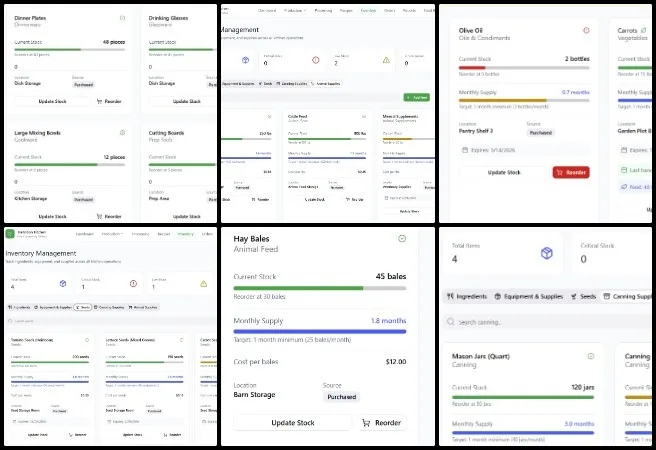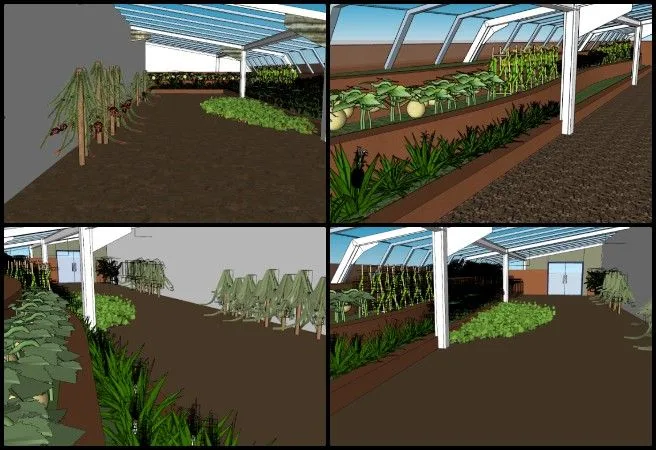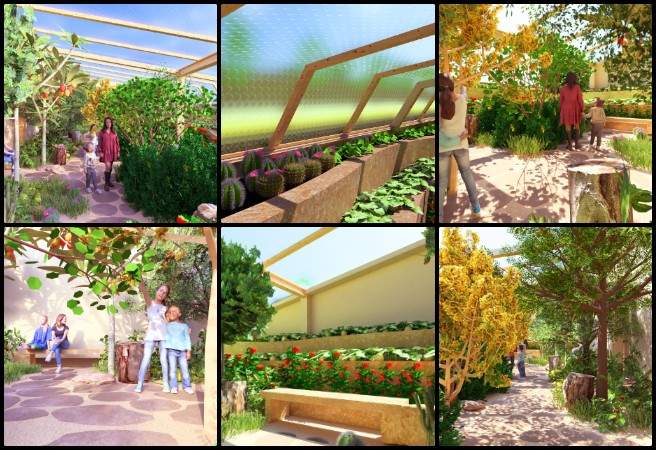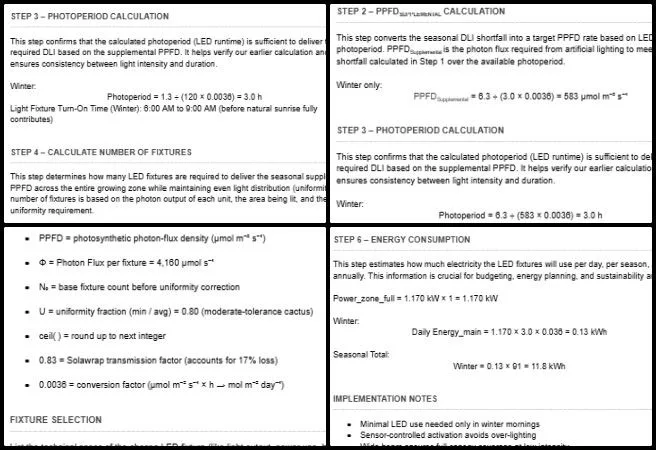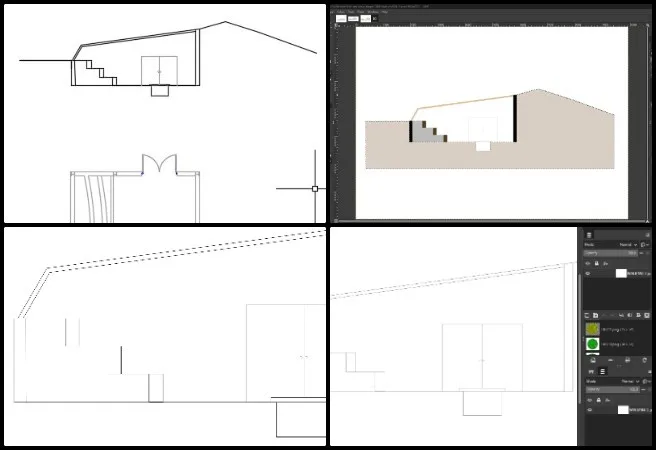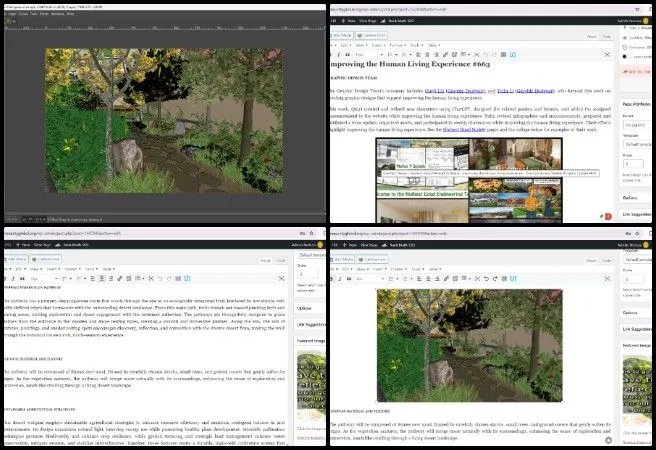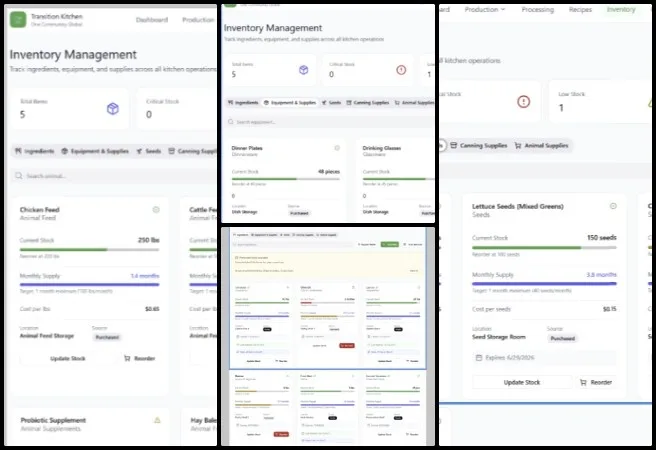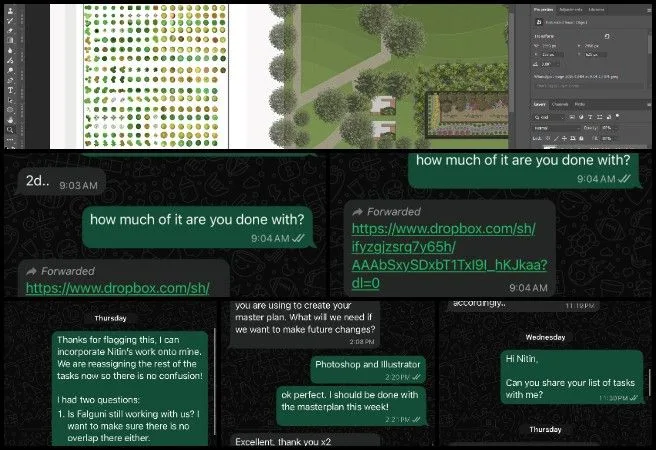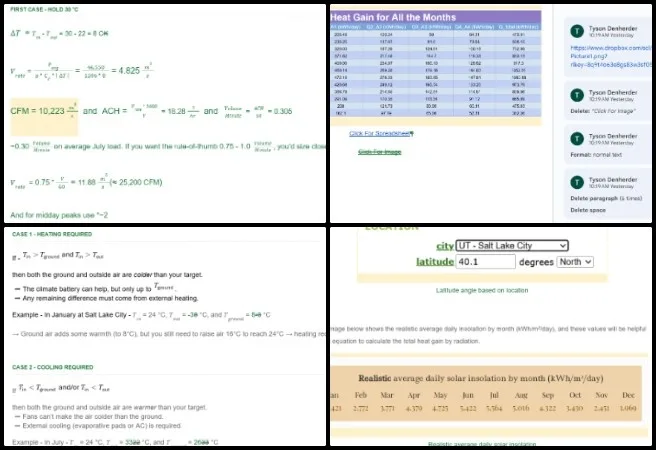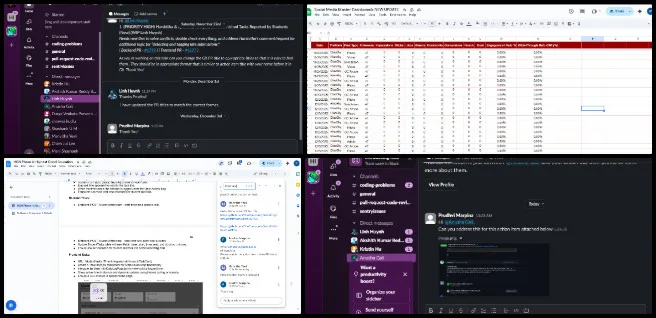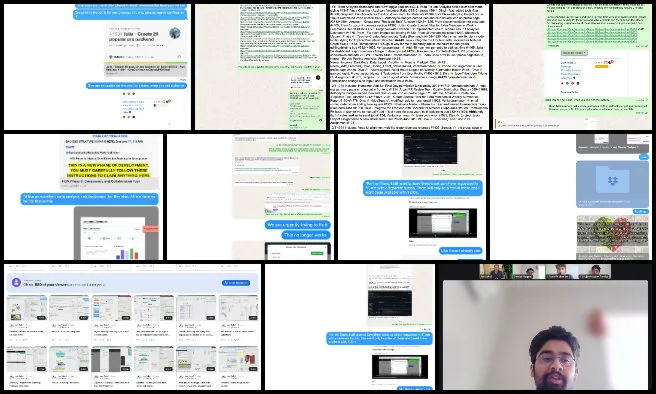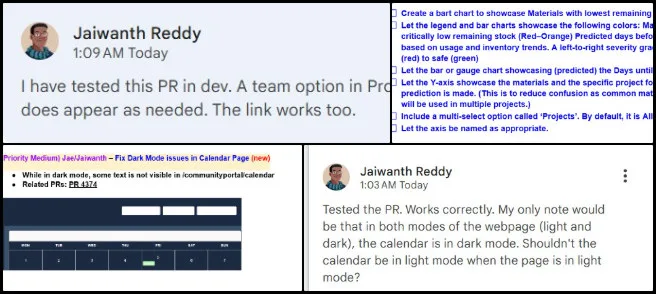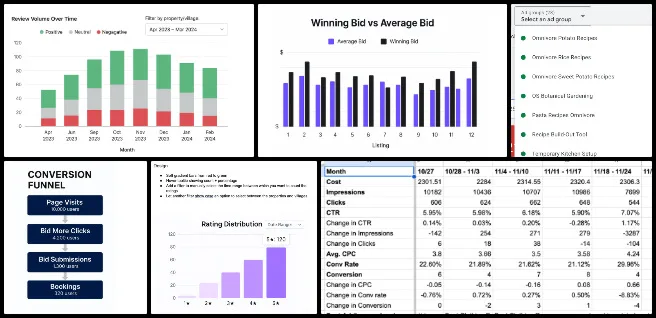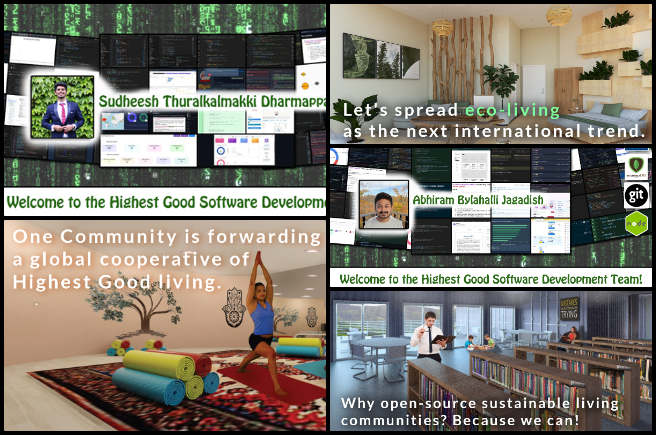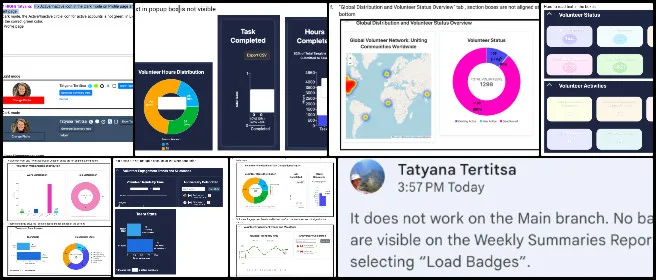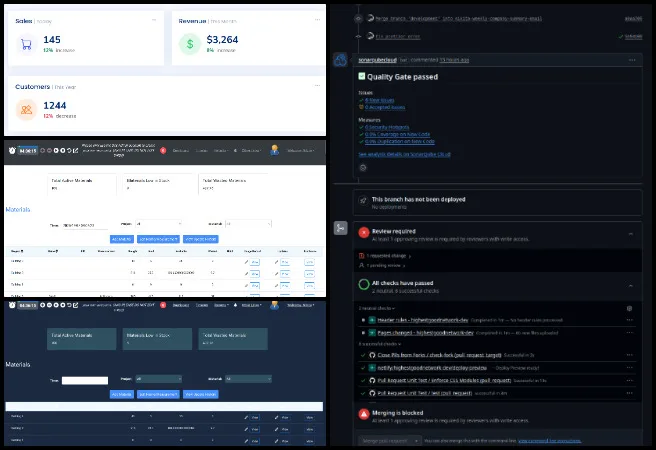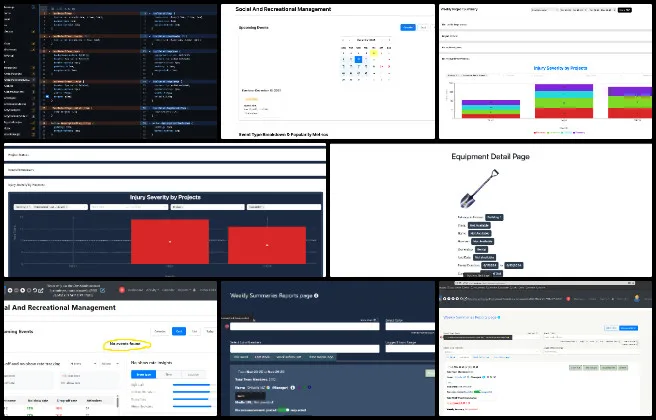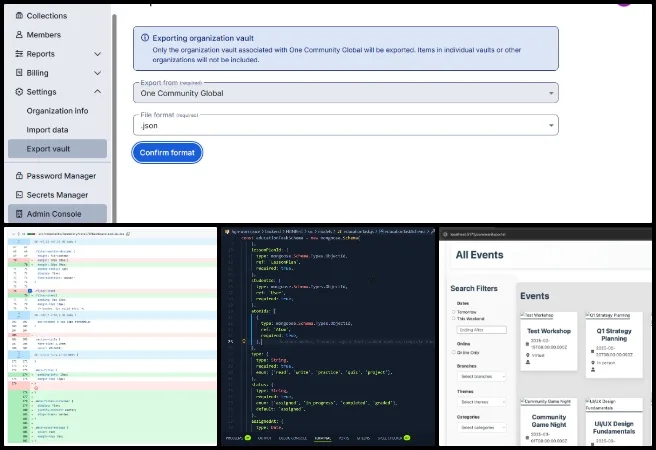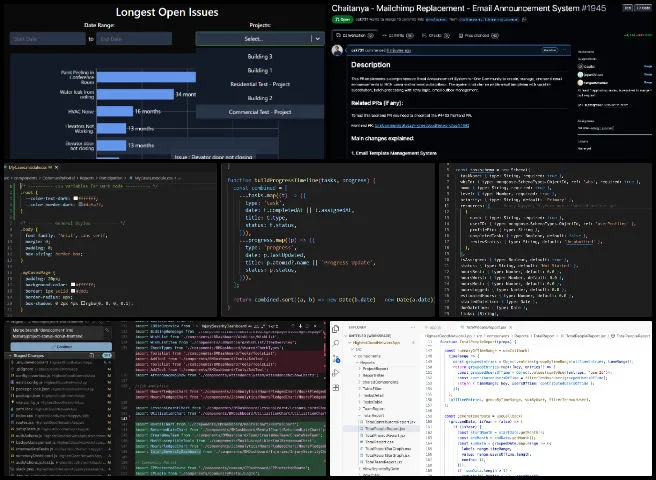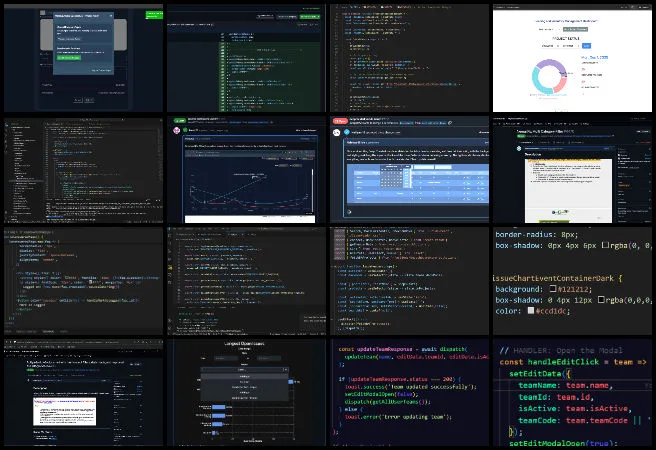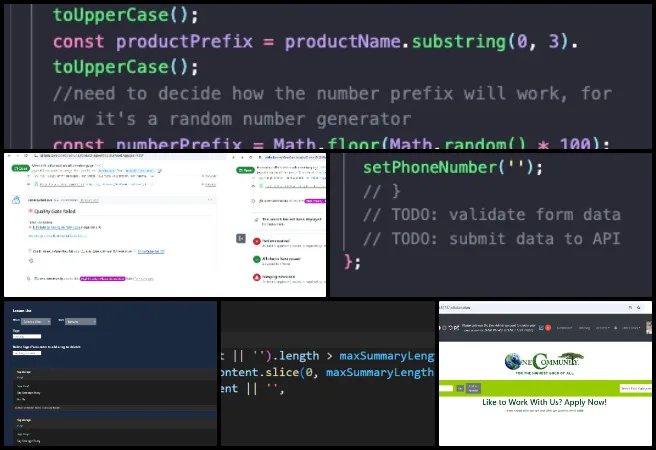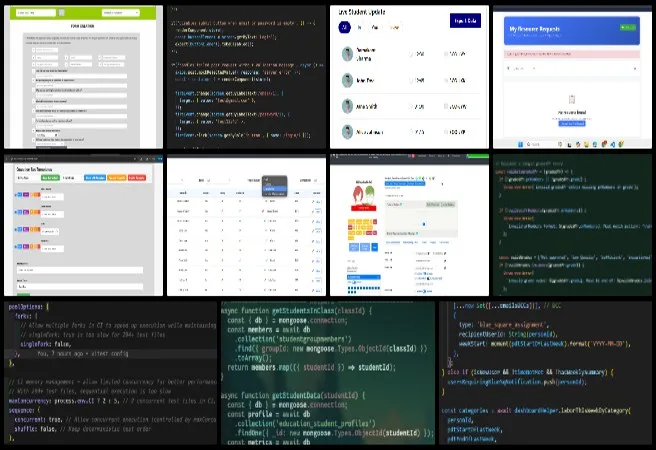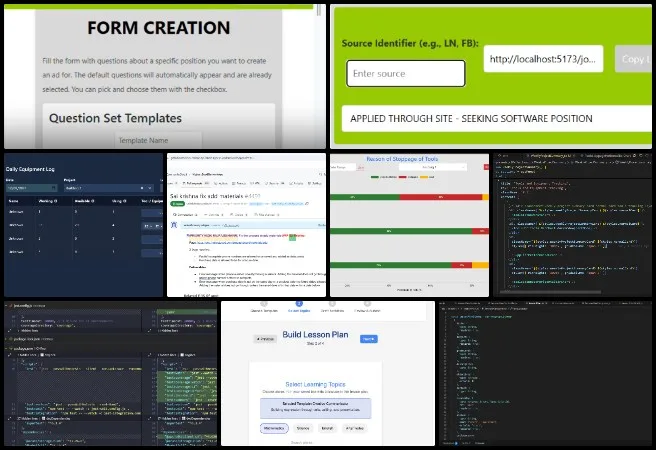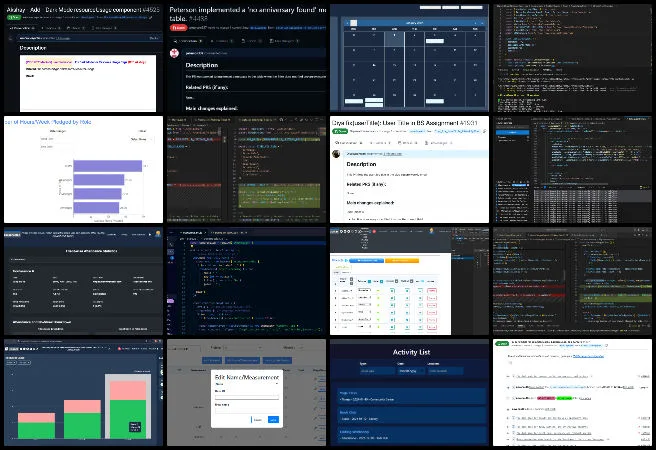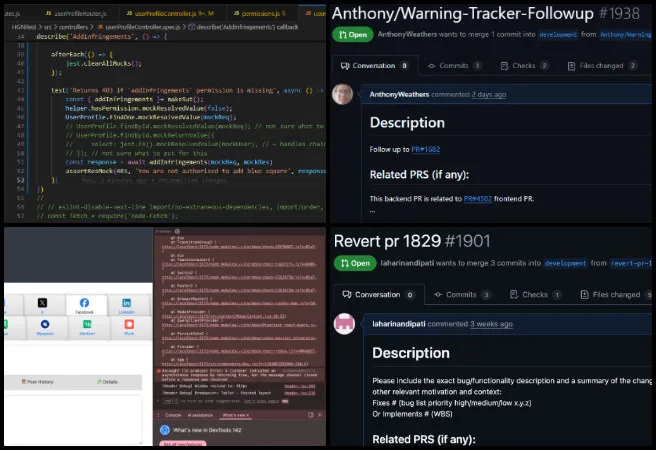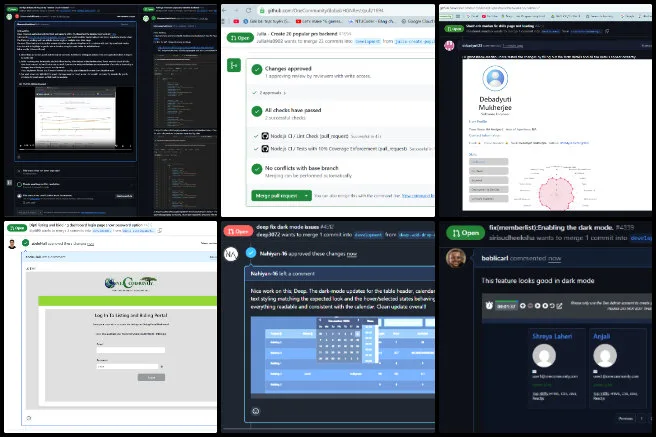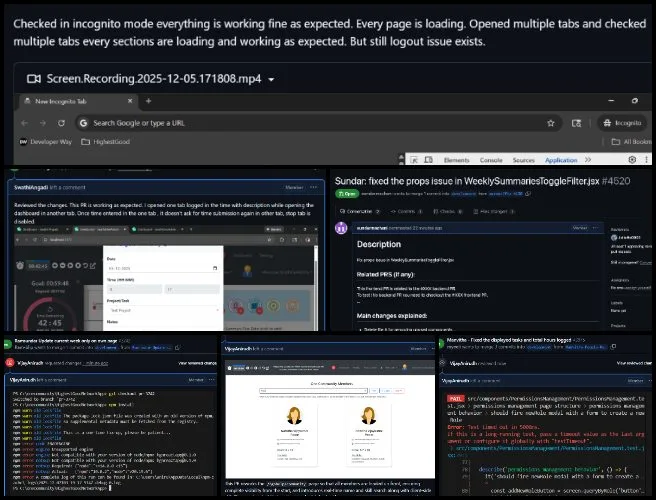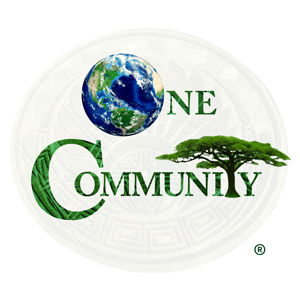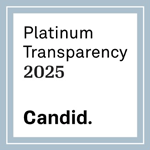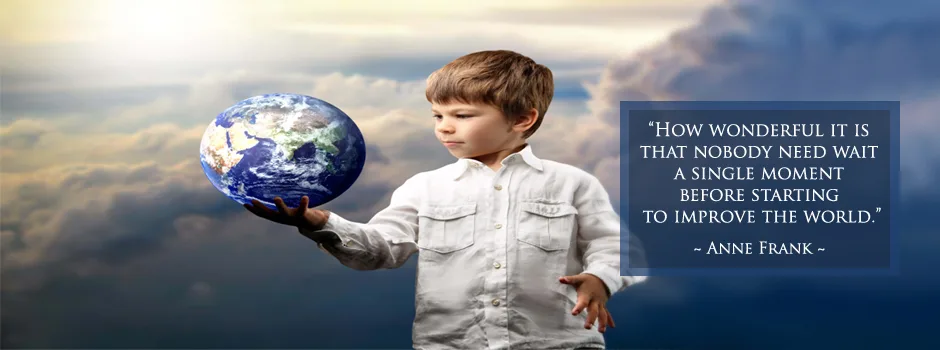
Creating the Sustainable Civilization We Know is Possible – One Community Weekly Progress Update #665
Posted on December 15, 2025 by One Community Hs
At One Community, we are focused on creating the sustainable civilization we know is possible by developing open source, free-shared solutions for food, energy, housing, education, economics, social architecture, and more. Created entirely by an all-volunteer team, our work supports a model that becomes self-replicating and grows into a global collaboration of teacher/demonstration hubs. Through evolving sustainability and global stewardship practices, we design approaches for fulfilled living and regenerating our planet, all with the intention of creating a world that works for everyone—always doing this for The Highest Good of All.
- Here’s our project overview
- Here’s our world-change methodology
- Here’s how this becomes self-replicating
- Here’s how we are open source and free-sharing all the do-it-yourself designs
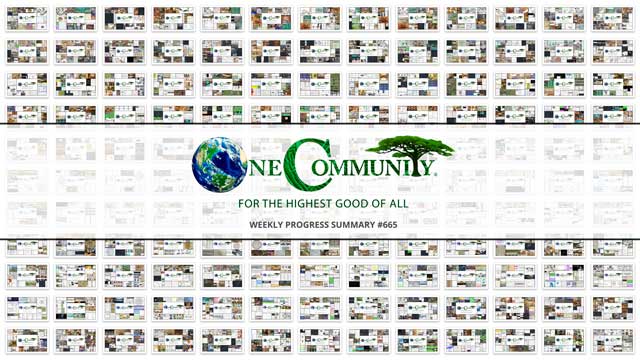
OUR MAIN OPEN SOURCE HUBS
Click on each icon to be taken to the corresponding Highest Good hub page.
One Community’s physical location will forward this movement as the first of many self-replicating teacher/demonstration communities, villages, and cities to be built around the world. This is the December 15, 2025 edition (#665) of our weekly progress update detailing our team’s development and accomplishments:
Creating the Sustainable Civilization
We Know is Possible
One Community Progress Update #665
DONATE | COLLABORATE | HELP WITH LARGE-SCALE FUNDING
CLICK HERE IF YOU’D LIKE TO RECEIVE AN EMAIL EACH WEEK WHEN WE RELEASE A NEW UPDATE
YOU CAN ALSO JOIN US THROUGH SOCIAL MEDIA
ONE COMMUNITY WEEKLY UPDATE DETAILS
HIGHEST GOOD HOUSING PROGRESS
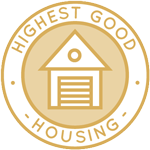 One Community is creating the sustainable civilization we know is possible through Highest Good housing that is artistic and beautiful, more affordable, more space efficient, lasts longer, DIY buildable, and constructed with healthy and sustainable materials:
One Community is creating the sustainable civilization we know is possible through Highest Good housing that is artistic and beautiful, more affordable, more space efficient, lasts longer, DIY buildable, and constructed with healthy and sustainable materials:
- Learn about: Our Upcoming Crowdfunding Campaign
- Learn about the different village models: 7 Sustainable Village Models
- Visit the open source portals for the first two: Earthbag Village OS Hub | Straw Bale Village OS Hub
This week, Ajay Adithiya Kumar Elancheliyan Tamilalagi (Mechanical Engineer) continued working on the ventilation system design for the Vermiculture Toilet component of the Earthbag Village. He focused on the Unistruct assembly and ventilation design for the vermicomposting eco-toilet space. He completed the first draft of Karthik’s report, made necessary revisions to his assigned section, and re-ran simulations to update the results. He continued developing the Unistruct report, finalized the analysis setup, and reviewed outcomes for displacement, von Mises stress, and strain under gravity and distributed mass loading. A separate document was created to incorporate updated weight calculations provided by Karthik, which required re-simulation, and Ajay also reviewed issues encountered with the HVAC simulation. In parallel, he continued editing the report while progressing with simulation work. His technical coordination and iterative analysis support creating the sustainable civilization we know is possible through open-source, performance-driven design. Below, you’ll find some images of this work.
Baraka Minja (Civil and Environmental Engineer Pr. Eng.) continued working on the Communal Eco-shower and Vermiculture Toilet drawings. He worked on building a paper model to represent the Duplicable City Center foundation connection, focusing on a physical illustration of the structural elements. Baraka used folded paper to depict the diagonal struts and added representations of the connecting channels to show how the components align. Bolt locations were marked using staples, allowing the model to demonstrate how fasteners would be positioned within the structure. This hands-on visualization helped clarify assembly logic and supported creating the sustainable civilization we know is possible by improving understanding of replicable construction systems. See below for some of the images.
Derrell Brown (Plumbing Designer) continued working on the Earthbag Village 4-dome home final MEP report by reviewing feedback from the initial draft and applying updates across multiple sections to improve clarity and alignment with project intent. He revisited the electrical content that had been previously added and expanded it by introducing new sections explaining the selected electrical service, including how the current configuration supports project needs and the practical benefits of the chosen approach. Derrell also began developing additional formulas related to panel sizing methods for inclusion in the report, focusing on clear presentation and consistency with standard electrical design practices. These refinements contribute to creating the sustainable civilization we know is possible by making complex infrastructure systems more accessible and reproducible. See below for some of the pictures related to this work.
Fangting Xu (Interior Design Intern) continued working with ADA codes related to building connections for the ADA 3-dome cluster of the Earthbag Village. She hosted the weekly meeting with Baraka and tracked task progress. Fangting reviewed Jae’s feedback on the ADA checklist for the 3-dome cluster and conducted further research on the connected path length between buildings. She also refined the ADA draft within the construction documents for the 3-dome cluster project, supporting creating the sustainable civilization we know is possible through inclusive, code-compliant design documentation. See below for some of the pictures related to this work.
Rishi Chakrapani (Mechanical Engineer) continued working on the Vermiculture Toilet. He verified Joseph’s calculations for the force on the drawer and winch and completed the corresponding report. Rishi reviewed feedback from Jae and incorporated it into the sensor selection and handle stress evaluation reports, with both documents updated to reflect the required changes. Errors identified in the earlier FEA of the dumping mechanism were also resolved, and the corrected analysis was integrated into the corresponding report to ensure the results aligned with the intended design criteria. His careful validation and documentation efforts reinforce creating the sustainable civilization we know is possible through accurate and transparent engineering analysis. See below for some of the pictures related to this work.
DUPLICABLE CITY CENTER PROGRESS
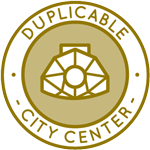 One Community is creating the sustainable civilization we know is possible through a Duplicable and Sustainable City Center that is LEED Platinum certified/Sustainable, can feed 200 people at a time, provide laundry for over 300 people, is beautiful, spacious, and saves resources, money, and space:
One Community is creating the sustainable civilization we know is possible through a Duplicable and Sustainable City Center that is LEED Platinum certified/Sustainable, can feed 200 people at a time, provide laundry for over 300 people, is beautiful, spacious, and saves resources, money, and space:
- Learn about this building and it’s function: Duplicable City Center Open Source Hub
This week, Ariana Virginia Gutierrez Doria Medina (Industrial Designer) continued working on the Duplicable City Center window and door framing by implementing new modifications to the insulation support structure to improve configuration and compatibility with the overall design. She also researched material options aligned with the project’s technical and functional requirements, developed a cost estimate, and defined the cutting layout to support efficient material usage and reduced fabrication waste. Ariana’s work on this open source Duplicable City Center project demonstrates creating the sustainable civilization we know is possible. See the presentation and research highlights below.
Ayushman Dutta (Mechanical Engineer) continued working on the City Center Dome Hub Connector Engineering and DIY manufacturing. He worked on the row 4 spreadsheet assembly drawings and verified dimensions for accuracy. He also made minor corrections to the hub connector model and participated in a team meeting to discuss identified bottlenecks. Ayushman continued updating the row 4 spreadsheet drawings, aligning the formatting with the row 3 structure for consistency, and integrated the assembly process document into the main file, reviewing it to confirm proper integration. This open source Duplicable City Center project demonstrates creating the sustainable civilization we know is possible. Review the connector analysis visuals below for more details.
Bevan Chiu (Mechanical Engineer Volunteer) continued his work finishing the City Center Eco-spa Designs. He finalized the plumbing assembly for the rectangular spa tub by setting pipe dimensions, creating assembly mates aligned with the AutoCAD drawing, and connecting the plumbing assembly to the overall tub layout. Bevan updated the model to maintain consistent alignment with the design drawings and verified interface points between major piping sections. He also worked on the inventory count for the bill of materials by calculating total pipe lengths, required fittings, and associated materials to support procurement planning. He researched methods for securing floating piping members, including a unistrut with post base mounting. This open source Duplicable City Center project contributes to creating the sustainable civilization we know is possible. For more details, refer to the image below.
Koushik Chandra Katta (Mechanical Engineer) continued working on the Duplicable City Center design. He worked on the dome cladding design by examining potential materials for installation on the outer surface to help reduce thermal bridging. His work included reviewing cladding options in relation to installation feasibility and thermal performance, along with meeting with Jae to clarify expectations for the mentor role and coordination related to ongoing FEA tasks. Koushik also discussed collaboration points with Shreyas and other team members to align on analysis-related responsibilities. This open source Duplicable City Center project contributes to creating the sustainable civilization we know is possible. See the image below for detailed analysis of this work.
Sandesh Kumawat (Mechanical Engineer) continued developing the City Center Eco-spa Designs. He rebuilt the spa hot tub preprocessing workflow in ANSYS Mechanical after identifying limitations in the previous setup and reorganized the full spa assembly, including the steel frame, inner shell, and foundation components, to maintain clean geometry and consistent hierarchy for analysis. Sandesh defined a part-specific meshing approach, applying shell elements for thin components and solid elements for volumetric components, and added local mesh refinements at critical interfaces such as frame connections, panel junctions, and load transfer regions. He reviewed mesh quality using standard element metrics, grouped major contact regions within the assembly, and applied fixed support conditions at the foundation interface to prepare the model for structural analysis. Updated ANSYS files, CAD geometry, and supporting documentation were organized and uploaded to the shared workspace. Discover One Community’s open source Duplicable City Center, which exemplifies creating the sustainable civilization we know is possible. See the visuals below for a closer look.
Shivarama Krishna Revanuru (Mechanical Engineer) continued working on the Duplicable City Center design. He reviewed project files and documentation to understand the design scope, technical background, and current system structure. Shivarama clarified the assigned responsibilities, reviewed the spa cover system requirements and constraints, and began initial design work focused on configuration and mechanical layout. This open source Duplicable City Center project exemplifies creating the sustainable civilization we know is possible. The images below illustrate aspects of this work.
Shreyas Nagaraj (Design Engineer) made more updates to the City Center Dome Hub Connector Engineering and beams for the Duplicable City Center. He clarified action items and task division related to the spa cover and reviewed an earlier design to understand its structure and identify improvement areas. Shreyas developed updated sketches and models, refined the spa cover design based on those findings, and prepared revised design drafts. He aligned the spa cover model with the updated spa tub structure to maintain consistency with the modified configuration. This open source Duplicable City Center project exemplifies creating the sustainable civilization we know is possible. For more details, refer to the image below.
Srujan Pandya (Mechanical Engineer) continued his work on developing the dynamic simulation setup for earthquake analysis updates for the City Center Dome Hub Connector Engineering. Srujan compared AutoCAD 2D and 3D files with the Inventor models used for FEA to ensure consistency across three dome configurations. Structural triangles and related components requiring removal at the cave openings were identified and marked, ensuring the simplified Inventor frame models accurately matched the physical domes shown in the SketchUp files. These elements were color coded in the simplified models to support clear reference during model updates. He also updated the tracking sheet with direct links to the relevant FEA files to support review and verification. The Duplicable City Center demonstrates creating the sustainable civilization we know is possible through open source solutions that can guide people. The images below illustrate aspects of this work.
Tianxiang Huang (Mechanical Engineer) continued working on the Duplicable City Center design. Tianxiang completed the analytical heat loss calculations and estimated the heater power requirement, identifying solar heat gain as a key variable that must be defined for accurate performance assessment. His work also included reviewing insulation material options and evaluating Hempcrete as a potential alternative, noting that its compressive strength could allow replacement of cinder blocks in noncritical areas to reduce heat loss to the ground. This open source Duplicable City Center project exemplifies creating the sustainable civilization we know is possible. For more details, refer to the image below.
HIGHEST GOOD FOOD PROGRESS
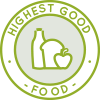 One Community is creating the sustainable civilization we know is possible through Highest Good food that is more diverse, more nutritious, locally grown and sustainable, and part of our open source botanical garden model to support and share bio-diversity:
One Community is creating the sustainable civilization we know is possible through Highest Good food that is more diverse, more nutritious, locally grown and sustainable, and part of our open source botanical garden model to support and share bio-diversity:
- Learn about the structures: Hoop House Hub | Aquapini & Walipini Open Source Hub
- See what we’ll be growing: Gardens & Hoop Houses | Large-scale Structures | Food Forest | TA
This week, the core team continued working on the Master Tools, Equipment, and Materials and Supplies List for the Large-scale Garden, Botanical Garden, and other Highest Good Food components. The team completed the Tools, Equipment, Materials/Supplies List for the Food Forest document, then moved on to the Hoop House document, finalizing summaries for this document and three prior weeks of project comparisons. The Hoop House doc, like other documents, includes fencing requirements to protect against wildlife grazing and crop destruction. The Highest Good Food initiative is a key component of One Community’s open source plans, focused on creating the sustainable civilization we know is possible and exemplifying the organization’s commitment through innovative design and implementation. Below are some images showcasing this work.
Anuneet Kaur (Administrator) continued her focus on the design of the Transition Food Self-sufficiency Plan components of the Highest Good food initiative. She continued working on the Food Procurement and Storage webpage and completed the Sustainable Food Nutrition Calculations and Food Self-Sufficiency Transition Plan webpages. Anuneet integrated Jae’s feedback and completed the SEO optimization of the Omnivore Rice, Vegan Potato, Sustainable Food Nutrition Calculations, and Food Self-Sufficiency Transition Plan webpages, achieving an SEO score of 90 or above. She ensured that each page followed updated formatting guidelines, corrected inconsistencies, and optimized all links for SEO across the recipe sections. She also reviewed titles, spacing, and layout alignment to maintain consistency throughout the Food Web project. Additionally, Anuneet ensured all team members were included in the live blog task and identified any missing participants. She reviewed Yulin’s infographic on sustainable research and provided detailed, constructive feedback. Anuneet fulfilled administrative responsibilities by editing summaries and collages for the Highest Good Society, Highest Good Education, and Core Teams, and reviewed fellow admin submissions to ensure completeness and accuracy. Her work contributes to creating the sustainable civilization we know is possible. Below are some images showcasing her work.
Chelsea Mariah Stellmach (Project Manager) continued working on the Transition Food Self-sufficiency food and inventory tracking software plans. She transitioned the kitchen management inventory software into the next phase following consultation with Jae, aligning on scope, priorities, and readiness to move forward. Chelsea began active collaboration with Bhanu, the engineer, to build the software from initial development through early implementation, translating prior planning and design work into technical execution. She met with Bhanu to clarify requirements, address open questions, and confirm expectations around functionality, structure, and development approach to ensure shared understanding of the direction forward. In parallel, Chelsea organized project documentation by adding all of Ravikumar’s Figma files to the shared Dropbox folder to support clear record keeping, version control, and ease of access for current and future contributors involved in the project. As an essential aspect of One Community’s open source goals, the Highest Good Food initiative supports creating the sustainable civilization we know is possible. The following images provide a view of her contributions.
Gayatri Pandkar (Architect) continued writing content for the various components of the Aquapini and Walipini aspects of the Highest Good Food initiative. She looked into plants and trees that would work well for the Walipini 3 structure and added them to the SketchUp model, adjusting their placement for optimal layout. Gayatri also started working on the people space, focusing on basic organization and how the plants affect movement, use of space, and how everything comes together in the design. The Highest Good Food initiative is a key part of One Community’s open source platform, focused on sustainable, participatory development, and creating the sustainable civilization we know is possible. Visual examples from her work are presented below.
Japneet Kour (Volunteer Architect) continued contributing to the Highest Good Food initiative. She updated wall and column textures for the Walipini Frost Free Arid Zone desert house to align with current design requirements, applying revisions as required. Japneet also added plant assets to the Walipini 3 tropical house based on the referenced report, adjusting species placement and density to match the documented guidance, organizing assets within the project files, and verifying that the changes reflected the specified environmental conditions and visual standards used for the model. The Highest Good Food initiative is a key part of One Community’s open source platform, focused on sustainable and participatory development while creating the sustainable civilization we know is possible. Visual examples from her work are presented below.
Jay Nair (BIM Designer) continued developing the Aquapini and Walipini Planting and Harvesting documents. He continued working on the standardization of the project documentation related to the lighting energy calculations for Greenhouse Walipini 1. Jay focused on aligning calculation content with the established document structure, ensuring consistency in formatting, terminology, and data presentation. He reviewed calculation sections to maintain clarity, updated headings and tables as needed, and adjusted the layout to better reflect the current scope and organization of the lighting energy analysis. The Highest Good Food initiative is a key part of One Community’s open source platform, focused on sustainable and participatory development while creating the sustainable civilization we know is possible. See below for pictures related to this work.
Nitin Parate (Architect) continued contributing to the Aquapini and Walipini renders and layout graphics. The structural design of the Walipini was studied to understand its construction principles, with some aspects identified for further clarification. Nitin prepared a basic Walipini section based on available study material and data from the project website to establish a starting point for ongoing work. Rendering of the Walipini 2 section began after setting up the base file, and work is currently in progress on adding visual layers and developing the section further. Construction sections are being developed in line with Jae’s suggestions, while existing sections are being reviewed to check consistency, accuracy, and alignment with overall project requirements. The Highest Good Food initiative is a key part of One Community’s open source platform, promoting regenerative and participatory development while creating the sustainable civilization we know is possible. Images below showcase his contributions.
Pallavi Deshmukh (Software Engineer) continued working on the Aquapini and Walipini Planting and Harvesting web details. She completed one interview and submitted the required details. Pallavi continued content from Gayatri’s work and incorporated that material into the Aquapini and Walipini Planting and Harvesting page. She edited images based on the specified requirements so they could be included on the page, reviewed the full page using Jae’s feedback, and submitted it for review. Pallavi also created new content for blog 664 and collaborated with her teammates by reviewing their suggestions and incorporating feedback to maintain a consistent and clear final version. In alignment with One Community’s open source objectives, the Highest Good Food project integrates creating the sustainable civilization we know is possible into a larger vision of regenerative living. Her contributions are highlighted in the collage below.
Shivangi Varma (Architectural Designer and Planner) continued the redesign of the Highest Good Food overall presentation, currently focused on the Aquapini and Walipini masterplan render. She coordinated with the architect volunteer to align next steps, deliverables, and pending graphics for the HGF Infrastructure projects while incorporating feedback to complete final updates to the masterplan render. Shivangi finalized the Zenipini, Aquapini, and Walipini structure package, including landscape and planting details and the furniture layout. She completed the overall HGF Infrastructure masterplan with furniture details across all three structure types and began producing the remaining graphics for the Highest Good Food Infrastructure in coordination with the architect volunteer. The Highest Good Food initiative plays a leading role in One Community’s open source platform by promoting sustainable and participatory development, focused on creating the sustainable civilization we know is possible. Below are visuals highlighting this work.
HIGHEST GOOD ENERGY PROGRESS
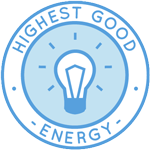 One Community is creating the sustainable civilization we know is possible through Highest Good energy that is more sustainable, resilient, supports self-sufficiency and includes solar, wind, hydro and more:
One Community is creating the sustainable civilization we know is possible through Highest Good energy that is more sustainable, resilient, supports self-sufficiency and includes solar, wind, hydro and more:
- Learn about the open source sustainable-energy foundations: Solar, Hydro, and Wind
- Explore our research into the most sustainable products and companies for saving water and energy: Insulation, Eco-laundry, Lightbulbs and Light Bulb Companies, Doors and Door Companies, Windows and Window Companies, Toilets, Faucets and Faucet Accessories, Urinals, and more.
This week, the core team continued contributing to the Highest Good Energy initiative. They reviewed the Highest Good Energy page and integrated the energy needs analysis summaries into the page. The team also finished reviewing the climate battery report, examined the food software mock-ups, and provided feedback on images related to the most sustainable options for insulation, paints, urinals, windows, and lighting. The Highest Good Energy initiative plays a leading role in One Community’s open source platform by promoting sustainable and participatory development, focused on creating the sustainable civilization we know is possible. Below are images related to this project.
HIGHEST GOOD EDUCATION PROGRESS
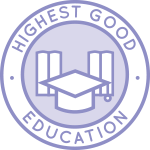 One Community is creating the sustainable civilization we know is possible through Highest Good education that is for all ages, applicable in any environment, adaptable to individual needs, far exceeds traditional education standards, and more fun for both the teachers and the students. This component of One Community is about 95% complete with only the Open Source School Licensing and Ultimate Classroom construction and assembly details remaining to be finished.
One Community is creating the sustainable civilization we know is possible through Highest Good education that is for all ages, applicable in any environment, adaptable to individual needs, far exceeds traditional education standards, and more fun for both the teachers and the students. This component of One Community is about 95% complete with only the Open Source School Licensing and Ultimate Classroom construction and assembly details remaining to be finished.
With over 8 years of work invested in the process, the sections below are all complete until we move onto the property and continue the development and open sourcing process with teachers and students – a development process that is built directly into the structure of the education program and everything else we’re creating too:
- Program Overview: Education Open Source Hub
- How the components work together in designing human orchestrated eco-abundance: How to use the Education for Life Program
- Lesson Plans for Life – Lesson Plans How-to
- Foundations of Outstanding Leaders, Teachers, and Communicators
- Curriculum for Life
- Teaching Strategies for Life
- Learning Tools and Toys for Life
- Evaluation and Evolution
This week, Prudhvi Marpina (Data Analyst) continued developing the Highest Good Education software platform, concentrating on Phase 4: marketing, promotion, and administrative activities. He worked primarily on Highest Good Network Phase 5 governance and decision-making software in his role as the development administrator by reviewing the entire Phase 5 document, coordinating with other development administrators, clarifying questions with leadership, and outlining the structure and next steps required to move the phase into active development. Prudhvi then supported Phase 4 software management by reviewing task assignments and Level 1 and Level 2 testing items, checking whether action items had the required reviews for merging, following up with developers on pending items, and updating the Phase 4 document to reflect current statuses. He also managed BlueSky social media activities by updating the analytics dashboard, maintaining the weekly volunteer tracker with current performance data, and scheduling upcoming posts using the established content planning process. In addition, he supported administrative efforts by updating the weekly blog entry and providing feedback on the administration team’s work as part of new administrator training support. Through these activities, he supported One Community’s commitment to creating the sustainable civilization we know is possible. The images below highlight his contributions.
HIGHEST GOOD SOCIETY PROGRESS
 One Community is creating the sustainable civilization we know is possible through a Highest Good society approach to living that is founded on fulfilled living, the study of meeting human needs, Community, and making a difference in the world:
One Community is creating the sustainable civilization we know is possible through a Highest Good society approach to living that is founded on fulfilled living, the study of meeting human needs, Community, and making a difference in the world:
- Read the Highest Good society overview: Highest Good Society
- Learn about the model for fulfilled living and sharing: A Day in the Life
- Learn about the 4 economic models: RBE | For-profit | Non-profit | Entrepreneurship
- Learn about our open source community collaboration and management software: The Highest Good Network
This week, the core team completed over 31 hours managing volunteer work reviews, handling emails, overseeing social media accounts, supporting web development, and identifying and integrating bug fixes for the Highest Good Network. The team also interviewed and onboarded new volunteer team members. Additionally, they produced and integrated the video above, which highlights how creating the sustainable civilization we know is possible serves as the foundation of One Community’s broader mission. The following images showcase highlights of this work.
Jaiwanth Reddy Adavalli (Project Manager) continued developing the Job Applicants page and key components of the Highest Good Network. He tested multiple pull requests of components in various parts of the HGN Software and created new action items to develop additional components. He met with Rajrajeshwari to discuss new features and finalize the action items in the listing and bidding dashboard. Jaiwanth tracked updates in software team management documents to support task management and, as a member of the pull request review team, reviewed submissions from the volunteer team assigned to him. This work supports One Community’s commitment to creating the sustainable civilization we know is possible. The images below highlight his contributions.
Rajrajeshwari Gangadhar Sangolli (Data Analyst) continued working on Google Ads management and strategy evolution of the Highest Good Network. She focused on content delivery, coordination, and campaign planning across multiple initiatives. Blog 664 was completed by covering steps one through four for eleven volunteers, and she added task details for charts to improve clarity and enable conversion into dashboard tasks. Rajrajeshwari scheduled a meeting with Jaiwanth, adjusted tasks, and updated the Figma file to reflect agreed designs. She also coordinated with Prudhvi to clarify documentation details and review the Phase 4 deliverables. This project supports One Community’s commitment to creating the sustainable civilization we know is possible. The images below highlight key aspects of her work.
Yagna Reddy Badvel (Data Analyst and Team Administrator) continued working on the Summary Dashboards and Weekly Report page on the Highest Good Network. He audited Phase 2 of the HGN Bugs & Features tracking system, checking for missing fields, outdated statuses, formatting issues, and broken links, and updated task descriptions and filters to keep it current. Yagna also completed weekly administration tasks by reviewing team submissions, providing feedback, updating tracking tables, and supporting blog preparation. This work supports One Community’s commitment to creating the sustainable civilization we know is possible. The images below highlight his contributions.
ADMINISTRATION TEAM
The Administration Team’s summary, which covers their work on the Highest Good Network, was managed by Prudhvi Marpina (Data Analyst) and includes Anusha Gali (Software Engineer), Ashutosh Mishra (Software Engineer), Divanshu Bakshi (Team Admin), Indra Anuraag Gade (Software Engineer and Team Administrator), Keerthana Chitturi (System Administrator), Neeharika Kamireddy (Data Analyst), Olawunmi “Ola” Ijisesan (Administrative and Management Support), Olimpia Borgohain (Data Analyst and Team Administrator), Priyanshi Sharma (Data Analyst and Team Administrator), Rajeshwari Bhirud (Administrator), Rishi Sundara (Quality Control Engineer and Team Administrator), Rishitha Adepu (Administrator), Sai Suraj Matta Veera Venkata (Business Data Analyst), Sayantan Paul (Volunteer Frontend Tester and Software Team Administrator), and Sudarshan Raju Chintalapati Venkata (Data Analyst). The Administration Team supports the Highest Good Network, a tool designed to track and measure progress while developing systems that contribute to creating the sustainable civilization we know is possible. Through administrative support, documentation, testing, training, recruiting, analytics, and content management, the team helps advance this mission, aligning with One Community’s vision of building a replicable and sustainable future model.
This week, Anusha focused on Level 2 Software Testing and QA by reviewing a large volume of frontend and backend pull requests across the HighestGoodNetworkApp and HGNRest repositories, validating functionality, dark mode behavior, filters, data loading, and API responses while documenting outcomes and required fixes. Ashutosh worked on multimodal system development by addressing integration bugs, implementing video splicing and vectorization workflows, migrating LangChain components to LangGraph, defining UI adjustments for chatbot output, and completing time log administration and follow-ups. Divanshu managed Mastodon operations by publishing and logging daily posts, documenting feature issues and enhancements, processing analytics data with Python, refreshing datasets, and validating dashboard accuracy. Indra contributed to the Code Crafters Team by preparing the weekly blog update, managing X/Twitter content and analytics, improving the ML pipeline through feature engineering and model refinement, updating technical documentation, and reviewing UI-related pull requests. This work supports One Community’s mission of creating the sustainable civilization we know is possible.
Keerthana handled administrative coordination by reviewing summaries for accuracy, updating Step 2 and Step 4 tracking documents, preparing the weekly blog, and assigning Phase 3 action items to developers. Neeharika supported software team operations by reviewing management documents, following up on assigned tasks, testing pull requests, verifying admin-submitted PDFs, completing weekly admin responsibilities, and conducting an interview shared with leadership. Ola improved documentation workflows by reorganizing the weekly summary report page, final review page, and administrative folders while updating her weekly report. Olimpia managed LinkedIn analytics by updating KPIs, completing senior admin reviews, resolving documentation comments, identifying warning and blue-square cases, and scheduling upcoming posts. These coordinated efforts contribute directly to creating the sustainable civilization we know is possible.
Priyanshi continued Phase 2 project testing by validating visualization behavior, filters, and feature functionality across light and dark modes, documenting issues related to mind maps, utilization charts, and messaging features with detailed PR references. Rajeshwari supported OC Administration by reviewing summaries, providing structured feedback, updating WordPress content with SEO keywords, incorporating team updates and collages, completing questionnaires, and conducting detailed testing of the BM Dashboard to ensure accurate data refresh and consistent filtering behavior. This work strengthens system reliability and transparency in support of creating the sustainable civilization we know is possible.
Rishi reviewed pending and completed pull requests, tested assigned PRs, followed up on merge conflicts through Slack, applied priority labels, and consolidated individual blogs into the main Blog #664 with SEO updates. Rishitha managed bio administration, followed up on missing information, uploaded Threads content, updated raw data and dashboards, maintained the volunteer tracker, and produced documentation and video resources. Sai Suraj handled Meta analytics by processing performance data, refreshing dashboards, updating raw data tabs, scheduling content, creating role-based video tutorials with documentation, organizing images, compiling summaries, and preparing weekly pages for publication. Sayantan tested and validated multiple trackers and dashboards, confirmed fixes, identified role-based access issues, documented UI and dark-mode inconsistencies, and suggested usability improvements. Sudarshan managed the Alpha Software Team blog through SEO updates, collages, pull request reviews, task creation, and multi-page testing across Phase 3 components. To learn more about how this work supports creating the sustainable civilization we know is possible, visit the Highest Good Society and Highest Good Network pages. Highlights of the team’s contributions are shown in the collage below.
GRAPHIC DESIGN TEAM
The Graphic Design Team’s summary includes Qinyi Liu (Graphic Designer) and Yulin Li (Graphic Designer), who focused this week on creating graphic designs that support creating the sustainable civilization we know is possible.
This week, Qinyi focused on social media marketing using a game-character visual style aligned with the mission. She used ChatGPT to create and refine character designs, pairing visuals with matching dialogue to produce promotional graphics. Yulin focused on visual communication and revised four infographics, published a team collaboration announcement, managed shared assets, and participated in weekly reviews. Their efforts highlight creating the sustainable civilization we know is possible. See the Highest Good Society pages and the collage below for examples of their work.
HIGHEST GOOD NETWORK PROGRESS
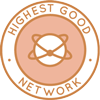 One Community is creating the sustainable civilization we know is possible through open source Highest Good Network® software that is a web-based application for collaboration, time tracking, and objective data collection. The purpose of the Highest Good Network is to provide software for internal operations and external cooperation. It is being designed for global use in support of the different countries and communities replicating the One Community sustainable village models and related components.
One Community is creating the sustainable civilization we know is possible through open source Highest Good Network® software that is a web-based application for collaboration, time tracking, and objective data collection. The purpose of the Highest Good Network is to provide software for internal operations and external cooperation. It is being designed for global use in support of the different countries and communities replicating the One Community sustainable village models and related components.
- Learn about our open source community collaboration and management software: The Highest Good Network
This week, the core team tested HGN pull requests and confirmed 10 as fixed. This effort highlights One Community’s commitment to creating the sustainable civilization we know is possible.
The following PRs were not fixed: the inline module CSS bugfix, creation of modules for CSS files, frontend for event participation analysis, Blue Square statistics pie chart, and the job posting page analytics donut chart showing applicants by experience. They also reviewed the Transition Kitchen Software proposal. In addition, they could not test the Phase 4 task completion “mark as done” PR because no data was available on the Main branch. This work strengthens One Community’s mission of creating the sustainable civilization we know is possible. See the Highest Good Society and The Highest Good Network pages, and the collage below, for an overview of the team’s contributions.
ALPHA SOFTWARE DEVELOPMENT TEAM
The Alpha Software Team, working on the Highest Good Network software, was managed by Lin Khant Htel (Frontend Software Developer). The team includes Nikita Kolla (Full Stack Developer). The Highest Good Network software is a key part of sustainable and free-shared eco-solutions, helping track and measure progress toward creating the sustainable civilization we know is possible. The software supports social architecture, construction, production, and maintenance processes that contribute to the open source project and resilient ecosystems. Designed to be portable and scalable, the Highest Good Network software is well suited for off-grid and sustainable living communities. This project reflects One Community’s open source commitment to creating the sustainable civilization we know is possible.
This week, Nikita completed administrative work by connecting tasks in the HGN app to GitHub pull requests and addressing merge issues for “Create Weekly Company Summary Email for Admins,” moving the contents of the routes.js file to the routes.jsx file in line with development standards and ensuring the code passed all tests. Nikita then worked on “Add Inventory Health Indicators and Summary Cards for Materials,” reviewing the existing code and problem description to understand the current structure before making progress on implementation. See the Highest Good Society and Highest Good Network pages for more on how this contributed to creating the sustainable civilization we know is possible. See the collage below to view the team’s work.
BINARY BRIGADE SOFTWARE DEVELOPMENT TEAM
The Binary Brigade Team, presenting their work on the Highest Good Network software, was managed by Amalesh Arivanan (Software Engineer) and included Kanishk Agarwal (Software Engineer), Apoorva Jain Ramapura Prashanth (Software Engineer), Taariq Mansurie (Full-Stack Developer), Sumedh Kumar (Full-Stack Developer), Ramsundar Konety Govindarajan (Software Engineer), Aswin “Tony” Kanikairaj (Software Engineer), and Nikhil Routh (Software Engineer). The Highest Good Network software is our tool for managing and objectively measuring progress, ensuring that all contributions are tracked and aligned with our mission, modeling, and creating the sustainable civilization we know is possible. The Highest Good Network software is our tool for managing and objectively measuring progress, ensuring that all contributions are tracked and aligned with our mission, modeling, and creating the sustainable civilization we know is possible.
This week, Kanishk resolved merge conflicts and code quality issues across several pull requests, including Phase 3 registration feedback status, Phase 4 Task Comments Frontend, Event Popularity Analytics landing page, time submission bug fix, page refresh and cross-tab logout sync, and an older bio criteria update. Nikhil continued CSS Modules migration for Equipment Details and Equipment Dashboard, converting remaining stylesheets, updating imports and class mappings, aligning older PRs with recent changes, fixing styling regressions, and coordinating on Phase III database and backend requirements. Aswin fixed the Lesson List Expand All feature by stabilizing expand/collapse state updates, replacing deprecated HTML parsing, correcting key mapping, updating LessonCard styling, and testing filters, sorting, tags, and interactions in light and dark mode. Amalesh updated mismatched team code logic, added a filter on the Weekly Team Summaries page, advanced the Toggle Request Bio Permission feature, and completed the disconnected timer refresh button work with testing, documentation, and onboarding steps.
Apoorva improved the MailChimp replacement email management system by redesigning multiple components with responsive layouts and dark mode support, adding filtering and search improvements, creating documentation, building admin tools, and addressing security and authentication issues. Ramsundar fixed broken Cancel and Submit behavior in the BM Dashboard Daily Equipment Log, restoring event handling, validation, loading states, Redux action updates, and post-submit synchronization. Sumedh updated the Tools and Equipments submit workflow, implementing state management, validation, submit handling, Redux support, and client-side previews, while reviewing backend structure for missing API endpoints. Taariq resolved merge conflicts, progressed the lesson plan table implementation, investigated production weekly summary logic, and continued debugging auto-scroll and caching issues while validating critical fixes and backend updates. See the Highest Good Society and Highest Good Network pages for more information on how this work models creating the sustainable civilization we know is possible. The collage below shows images of their work.
BLUE STEEL SOFTWARE DEVELOPMENT TEAM
The Blue Steel Software Team, working on the Highest Good Network software, was managed by Divanshu Bakshi (Product Manager), and includes Linh Huynh (Software Engineer), Som Ramnani (Software Engineer), and Sheetal Mangate (Software Engineer). This week, the team focused on long-term impact, responsible innovation, systems thinking, collaboration, and creating the sustainable civilization we know is possible.
Som resolved a MongoParseError caused by a malformed MongoDB connection URI by validating the connection string, environment variables, credentials, special character handling, dotenv load order, and connection execution flow. He determined that Node v25 was not supported by the MongoDB Node driver for SRV URIs and resolved the issue by reverting to Node v20. Som also revisited PR#4428 to fix merge conflicts and rebase errors, adjusted DatePicker padding, identified a Node warning related to local storage, and investigated a failing test requiring branch cleanup. Linh continued work on existing tasks, making improvements, fixing identified issues, and reviewing documentation to support upcoming implementations. Sheetal focused on creating secrets, projects, and machine accounts in Bitwarden, studied official resources for API key creation, referenced SDK integration materials, and identified an issue with the Bitwarden LogLevel configuration that needs further investigation, supporting creating the sustainable civilization we know is possible.
CODE CRAFTERS SOFTWARE DEVELOPMENT TEAM
The Code Crafters Team, covering their work on the Highest Good Network software, was managed by Indra Anuraag Gade (Software Engineer and Team Administrator) and includes Ajay Naidu (Software Engineer), Akshith Kumar Reddy Balappagari Gnaneswara (Software Engineer – Full Stack), Bhanu Anish Akkineni (Software Engineer), Chaitanya Swaroop Kumar Allu (Software Engineer), Sphurthy Satish (Software Engineer). The Highest Good Network software is how we’ll manage and objectively measure our progress in creating the sustainable civilization we know is possible through our social architecture, construction, production, and maintenance efforts, while supporting widespread and lasting eco-lifestyle access.
This week, Ajay advanced merge requests and resolved theme-related issues impacting dark mode by adding input filters, implementing filtering logic, integrating controls with the layout, introducing state persistence, validating real-time updates, reviewing color tokens and component styles, checking interaction flows, and preparing updates for review. Akshith completed the Phase 4 Individual Student Report Generation backend, adding role-based access controls, validating endpoint output, updating the Event Popularity page header, and progressing on the PR Admin Dashboard with styling and browser access fixes. Anish prepared Phase 4 HGN deliverables and an action items document for kitchen and inventory management software by reviewing Figma documentation, analyzing workflows, identifying required database models, and defining core application components.
Chaitanya implemented and refined the Phase 2 Lesson Data Export for the BM Dashboard Lesson List by building an ExportConfirmationModal, applying filters and validations, integrating notifications, fixing export issues, and completing thorough testing. Sphurthy fixed UI misalignment in the Community Portal “All Events” filter sidebar, standardizing spacing, adjusting alignment, updating padding and gaps, and ensuring consistency with Bootstrap’s grid system. These contributions strengthen One Community’s mission and commitment in creating the sustainable civilization we know is possible. The collage below shows an overview of this team’s work.
DEV DYNASTY SOFTWARE DEVELOPMENT TEAM
The Dev Dynasty Team’s summary, covering their work on the Highest Good Network software, was managed by Vamsidhar Panithi (Software Engineer) and includes Adithya Cherukuri (Volunteer Software Engineer), Aditya Gambhir (Software Engineer), Deekshith Kumar Singirikonda (Developer), Manvitha Yeeli (Software Engineer), Nahiyan Ahmed (Full-Stack Software Developer), Neeraj Kondaveeti (Software Engineer) and Sriamsh Reddy (Software Engineer). The Highest Good Network software is how we’ll manage and objectively measure our processes for open sourcing a better world through social architecture, construction, production, and maintenance. This progress supports One Community in creating the sustainable civilization we know is possible.
This week, Nahiyan reviewed PR 4548, confirming that a separate data fetch for hours completed was merged correctly and adding validation for null values in task and project statistics. Adithya focused on the HGN Software Development project, fixing the ‘Edit Existing Team’ redirect, refactoring the dashboard for real-time data, addressing SonarCloud warnings, and implementing a loading state to prevent duplicate save requests. Aditya designed and debugged a Material Usage vs Cost Correlation API endpoint, built utility modules for date parsing, query validation, and MongoDB aggregation pipelines, and updated 74 purchase records to correct zero-cost issues. Deekshith developed data logic and visual structures for a dashboard-style interface, handling state, Redux integration, side effects, and memoized calculations.
Manvitha developed the Phase 3 Community Portal feedback form with dark mode support, including a five-star rating system and optional comment field, while resolving merge conflicts and CI failures. Neeraj worked on the Get List button and modal functionality for Drop-off and No-show Rate Tracking, implemented UI and state logic, and resolved merge conflicts and SonarQube duplication issues. Sriamsh implemented sorting and ranking for the Returned Late Chart and started the Add Click-to-Expand Detail Panel for tool-level breakdown. Vamsidhar updated multiple PRs, resolved issues with the Share PDF button, integrated loading states and toast notifications, and fixed frontend test failures caused by dependency updates. See the Highest Good Society and Highest Good Network pages for more on how this relates to our mission of creating the sustainable civilization we know is possible. Explore some of the team’s work in the collage below.
EXPRESSERS SOFTWARE DEVELOPMENT TEAM
The Expressers Team’s summary, which covers their work on the Highest Good Network, was managed by Rahul Trivedi (Software Engineer) and includes Casstiel Pi (Software Engineer) and Layne Taylor (Software Engineer). This effort supports One Community’s goal of creating the sustainable civilization we know is possible.
This week, Casstiel started work on a new task to enhance filter and tag selection with multi-select and auto-suggest functionality. He reviewed the current codebase, analyzed possible solutions, and drafted an initial enhancement to treat filters, tags, and sorting options as composable inputs feeding into a unified filtering pipeline. The approach allows heavier filtering operations to be delegated to the backend as the dataset grows. The lesson box clicking error still needs to be implemented on the dev or live branch, as the site crashes when clicked. Layne worked on generating the SKU and changing the search material input from a modal to a search bar on the ItemListView file. She resolved early issues separating the SKU state from formData, completed SKU generation to display in an input box, and addressed backend challenges caused by unclear naming conventions and model imports. She shifted focus to the search bar work, where filtering is not yet implemented and debounce still needs to be added. This work directly contributes to One Community’s mission of creating the sustainable civilization we know is possible.
Rahul optimized code to address linting issues in src/components/Badge and reorganized code files to align with project guidelines. He resolved merge conflicts in PR 4124 and updated specific lines to match formatting standards. Rahul also supported team coordination by assisting teammates, clarifying doubts, holding a weekly Zoom meeting, and reviewing submitted summaries, videos, and images to ensure alignment with team expectations. See the Highest Good Society and Highest Good Network pages for more on how this work contributes to creating the sustainable civilization we know is possible. See the collage below to view the team’s work.
LUCKY STAR SOFTWARE DEVELOPMENT TEAM
The Lucky Star Team’s summary, covering their work on the Highest Good Network, was managed by Keerthana Chitturi (System Administrator) and Sohail Uddin Syed (Software Engineer). The team includes contributions from Abhishek Jain (Software Engineer), Aryan Rachala (Software Engineer), Chirag Bellara (Software Engineer), Dipti Yadav (Software Engineer), Durga Venkata Praveen Boppana (Software Engineer), Shashank Madan (Software Engineer), Shravya Kudlu (Software Development Engineer), Veda Bellam (Software Engineer), Venkataramanan Venkateswaran (Software Engineer) and Vinay Krishna (Software Engineer). Their work supports One Community’s goal of creating the sustainable civilization we know is possible through cross-functional software development and ongoing system improvements.
This week, Abhishek transitioned into knowledge transfer mode as he prepares to leave the organization, focusing on handoff documentation for the Code Coverage Improvement Initiative and GitHub runner optimization. He created walkthrough videos explaining automated testing enforcement in the HGNRest repository, the frontend PR (#4114), and GitHub runner performance findings, and organized ClickUp workflows and troubleshooting guides for continued progress. Aryan implemented search bar functionality and filters for the Attendance Tracking Admin Dashboard, building state management and event handlers while refining the interface for smoother UI updates. Chirag completed tools filters functionality (PR #4535), added state persistence logic, and is addressing a dark mode issue on the Tools Table as well as an Activity Resource Usage page error. Dipti fixed the Active/Inactive icon in Dark Mode on the Profile and User Management pages, implementing changes in ActiveCell.jsx and Timelog.css and verifying the functionality. Durga designed the Teacher Resource Request Form, resolved feedback on the student evaluation form, and began preparing dark mode features for the Total Org Summary page. Shashank planned the frontend structure for the PR Grading Dashboard, built placeholder components, and implemented mock data handling with modularized CSS and grading record versioning.
Shravya finalized testing and documentation for Phase 4 – Class Performance Report Generation (PR #1942), resolved merge issues, and addressed SonarQube blockers. Sohail validated email threading schema consistency and updated cron job subject line logic to maintain proper grouping. Veda contributed to the Job Application Listing Page and user application form page, resolving merge conflicts and improving UI/UX alignment while handling questionnaire data. Venkataramanan implemented frontend improvements and bug fixes, including button alignment, progress bar widths, profile load time, and layout consistency across WBS and Teams pages. Vinay completed updates for Indra’s Application/Job Posting Page (PRs #2928 and #1167), fixing template save workflows and improving interface wording. See the Highest Good Society and Highest Good Network pages to learn more about how this work supports creating the sustainable civilization we know is possible. See the collage below highlighting the team’s work for the week.
MOONFALL SOFTWARE DEVELOPMENT TEAM
The Moonfall Team’s summary, which covers their work on the Highest Good Network, was managed by Bhavpreet Singh (Software Engineer) and includes Aayush Shetty (Software Engineer), Alisha Walunj (Software Engineer), Mani Shashank Marneni (Software Engineer), Sai Krishna (Software Engineer), Sudheesh Thuralkalmakki Dharmappa Gowda (Full Stack Developer), and Uha Kruthi (Software Engineer). Their efforts support One Community by advancing the mission of creating the sustainable civilization we know is possible through open-source collaboration, ecologically responsible innovation, and holistic global progress.
This week, Bhavpreet completed a feature enabling teaching group additions within the education portal, progressed backend work for the badge system, and resolved merge conflicts across previously submitted pull requests. Sai refined the purchase date and phone number fields on the Add Materials page, updating validation logic and country-specific formats while preparing a pull request. Uha enhanced the BM Dashboard Issues chart with a Clear Filters button, ensured light and dark mode consistency, validated functionality locally, and documented usage notes. Sudheesh improved UI and accessibility, added column-specific tooltips to the Daily Equipment Log, refined Project Risk Graph tooltips for dark mode, and corrected data retrieval logic for the Student Profile Educational Progress view.
Aayush developed the Global Distribution of Projects pie chart by defining routes, models, and test data, while investigating the Issues page Back to Projects button behavior. Alisha worked on collaborative lesson plan creation by fixing draft activity display, implementing the review and submit flow, and aligning backend controllers and schemas. Mani completed the Application and Job Posting dark mode task, applied dashboard styling patterns, corrected visual artifacts, and ensured child components inherited dark mode behavior before submitting Pull Request 4500. Visit the Highest Good Society and Highest Good Network pages for more on how this work supports creating the sustainable civilization we know is possible through open-source development and globally accessible resources. The collage below reflects the team’s primary accomplishments for the week.
REACTONAUTS SOFTWARE DEVELOPMENT TEAM
The Reactonauts Team’s summary, covering their work on the Highest Good Network, was managed by Sai Suraj Matta Veera Venkata (Business Data Analyst) and Akshay Jayaram (Software Engineer). The team includes Aseem Deshmukh (Software Developer), Diya Wadhwani (Software Developer), Guna Pranith Reddy Cheelam (Software Developer), Namitha Vijaykumar Pawar (Software Engineer), Peterson Rodrigues dos Santos (Full Stack Developer), Siva Putti (Software Engineer), Sri Satya Venkatasai Siri Sudheeksha Vavila (Software Engineer), Suparshwa Patil (Software Engineer), and Tom Linn (Software Engineer). The Highest Good Network software helps manage and objectively measure progress by focusing on demonstrating creating the sustainable civilization we know is possible. It supports social architecture, construction, production, and maintenance processes to build sustainable and thriving ecosystems, further supporting creating the sustainable civilization we know is possible.
This week, Akshay resolved the merge conflict from PR4477 by creating and merging PR4556, including dark theme refinements, layout spacing fixes, and conditional color handling, while coordinating daily pull requests and supporting contributors with Git branching issues. Aseem improved UI accessibility and data visualization, fixing contrast issues and numeric formatting through PR4546, contributing to creating the sustainable civilization we know is possible. Diya corrected weekly summary aggregation, email Reply-To handling, and UTC/PST alignment issues across PRs 1948, 1950, 4541, and 4532. Guna refined the listings home page and addressed routing issues in the Dev environment, supporting creating the sustainable civilization we know is possible. Namitha enabled calendar functionality on the Activities Register page, converted styles to CSS modules, and improved responsiveness through PR4544.
Peterson fixed the Teams page filter toggle, ensuring active and inactive users function correctly via PR4534, contributing to creating the sustainable civilization we know is possible. Siva delivered Phase 3 updates including organizer logo rendering, accessibility improvements, and a new ActivityFAQs route under PR4523. Sudheeksha applied technical fixes to separate inputs for tools and equipment across multiple files. Suparshwa implemented video audio processing and transcription for downstream storage. Tom resolved styling issues from missing imports in PR4440, verified fixes, collaborated with team members, and documented findings, further supporting creating the sustainable civilization we know is possible. See the Highest Good Network and Highest Good Society pages to learn more about how this work supports the modeling and pioneering of creating the sustainable civilization we know is possible. See below for the work done on demonstrating creating the sustainable civilization we know is possible.
SKYE SOFTWARE DEVELOPMENT TEAM
The Skye Team’s summary, covering their work on the Highest Good Network, was managed by Sayantan Paul (Frontend Tester and Software Team Administrator) and Anthony Weathers (Software Engineer). The team includes Lavanya Lahari Nandipati (Software Developer) and Marcus Yi (Software Engineer). The Highest Good Network software objectively tracks and manages progress, with a focus on creating the sustainable civilization we know is possible. It supports social architecture, construction, production, and maintenance processes that foster sustainable and thriving ecosystems. Designed to be portable and scalable, this solution is ideal for off-grid and sustainable living communities – a practical example of creating the sustainable civilization we know is possible.
This week, Lavanya fixed badge assignment and badge history issues by updating backend logic, correcting duplicate entries, and validating calculations against badge rules, ensuring weekly and cumulative hour badges updated properly. Marcus resolved permission and routing issues affecting Facebook posting, reviewing and updating frontend-backend routes and verifying that posts successfully processed. Anthony addressed SonarCloud-reported issues blocking PR#4502, resolved code duplication, reviewed email automation PR#1788 for proper threading, and finalized PR#3600 by converting styling to module-based CSS. By resolving these challenges, their work continues to support One Community’s mission of creating the sustainable civilization we know is possible. See the See the Highest Good Society and Highest Good Network pages for more on how this contribution advances One Community’s goals of creating the sustainable civilization we know is possible in the Highest Good Network open source hub.
SOFTWARE PR REVIEW TEAM A-N
The PR Review Team’s summary for members with names starting A–N, managed by Neeharika Kamireddy (Data Analyst), highlights their contributions to the Highest Good Network software. This platform forms the foundation for measuring our results in creating the sustainable civilization we know is possible. Active team members included Abdelmounaim Lallouache (Software Developer), Carl Bebli (Software Developer), Debadyuti Mukherjee (Software Engineer), Julia Ha (Software Engineer), Nahiyan Ahmed (Full Stack Software Developer), and Nathan Hoffman (Software Engineer). They supported the project by reviewing all pull requests shared this week. Learn more about how the Highest Good Network tracks progress toward creating the sustainable civilization we know is possible in the Highest Good Network open source hub. The collage below showcases a compilation of this team’s work.
SOFTWARE PR REVIEW TEAM O-Z
The PR Review Team’s summary for team members with names starting from O–Z, covering their work on the Highest Good Network software, was managed by Jaiwanth Reddy Adavalli (Software Project Manager). The Highest Good Network software is a foundation for measuring our results in creating the sustainable civilization we know is possible. This week’s active members of this team were: Sundar Machani (Software Engineer), Swathi Angadi (Software Engineer), Vijay Anirudh (Software Development Engineer), and Yiyun Tan (Software Engineer). They reviewed all the Highest Good Network PRs (Pull Requests) shared in this week’s update. Learn more about how the Highest Good Network open source hub measures progress towards our goal of creating the sustainable civilization we know is possible. The collage below shows a compilation of the work from this team.
AND WE PRODUCED THIS WEEKLY UPDATES BLOG – CLICK HERE TO SUBSCRIBE
FOLLOW ONE COMMUNITY’S PROGRESS (click icons for our pages)
INVESTOR PAGES
GET INVOLVED
One Community Welcomes Vivek Chandra Bengaluru Suresh to the Software Development Team!
Posted on December 11, 2025 by One Community Hs
One Community welcomes Vivek Chandra Bengaluru Suresh to the Software Team as our newest Volunteer/Consultant!
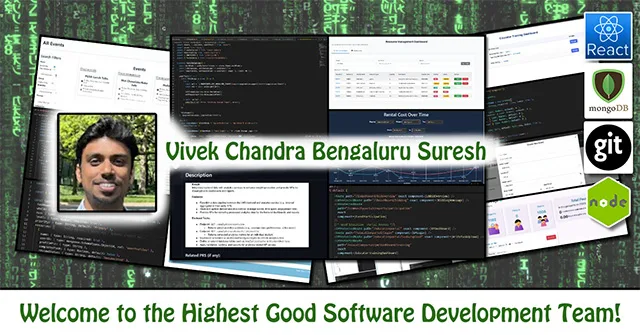
Vivek is a software engineer with over five years of experience developing scalable full-stack applications and AI-driven systems across industries, including e-commerce, SaaS, and media technology. He specializes in backend architecture, cloud infrastructure using AWS, and generative AI systems built with LangChain and GPT-based models. His professional interests include developing reliable AI systems, optimizing backend performance, and creating automation workflows that improve system scalability and efficiency. As a member of the One Community Global Software Team, Vivek has contributed to the Highest Good Education, focusing on Seeder scripts and database schema design to ensure robust data modeling and streamlined setup processes—helping lay the foundation for an efficient and scalable education platform.
WELCOME TO THE TEAM VIVEK!
FOLLOW ONE COMMUNITY’S PROGRESS (click icons for our pages)
INVESTOR PAGES
GET INVOLVED
One Community Welcomes Sudarshan Raju Chintalapati Venkata to the Management Team!
Posted on December 11, 2025 by One Community Hs
One Community welcomes Sudarshan Raju Chintalapati Venkata to the Management Team as our newest Volunteer/Consultant!
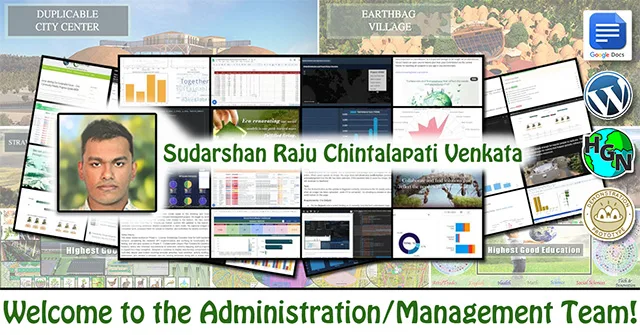
Sudarshan has recently graduated with a Master’s degree in Information Systems (MIS) from the University of Memphis. With a strong foundation in data visualization, software development, and project coordination, he specializes in leveraging technologies such as Python, R, SQL, Power BI, and Tableau to enhance system functionality and improve user experience through data-driven insights and structured design. As part of the One Community Global team working on the Highest Good Network, he has worked on testing the HGN Phase 2 project with multiple modules, including Total Construction Summary dashboards, Lessons Learned analytics, and Equipment and Materials management. His contributions include designing and refining interactive dashboards, creating tasks for new display cards and analytics components, improving dark-mode compatibility, fixing UI/UX workflow issues, and resolving data-accuracy bugs.
WELCOME TO THE TEAM SUDARSHAN!
FOLLOW ONE COMMUNITY’S PROGRESS (click icons for our pages)
INVESTOR PAGES
GET INVOLVED
One Community Welcomes Ashutosh Mishra to the Management Team!
Posted on December 11, 2025 by One Community Hs
One Community welcomes Ashutosh Mishra to the Management Team as our newest Volunteer/Consultant!
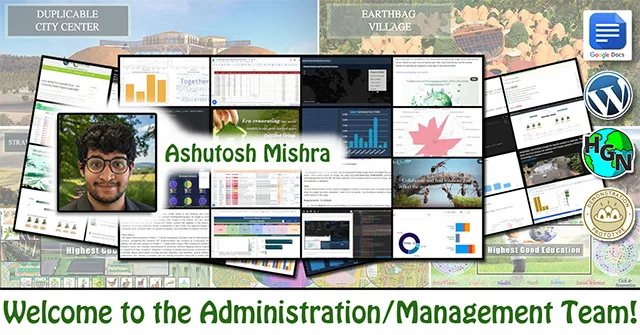
Ashutosh is a software engineer with a diverse background spanning Electronics and a Master’s in Computer Science. He brings full-stack expertise and a systems-level understanding to deliver highly optimized solutions. He has a proven track record of architecting infrastructures capable of handling over 100,000 requests per minute while reducing latency by 25%. As part of the One Community team, Ashutosh has played a key role in developing an intelligent, agentic, AI-powered virtual assistant. This assistant integrates seamlessly with the backend of the Highest Good Network software, performing agentic actions such as fetching reports, sending emails, and assigning BlueSquares, all governed by robust Role-Based Access Control (RBAC) mechanisms that ensure secure and effortless user interaction. Currently, he is also leading efforts to extend the assistant into a 3D avatar interface of the Learning Tools and Toys for Life, transforming it into an engaging, conversational front-end that enhances user experience.
WELCOME TO THE TEAM ASHUTOSH!
FOLLOW ONE COMMUNITY’S PROGRESS (click icons for our pages)
INVESTOR PAGES
GET INVOLVED
Adaptable Eco-models for Social Evolution – One Community Weekly Progress Update #664
Posted on December 8, 2025 by One Community Hs
At One Community, we share our mission of adaptable eco-models for social evolution through evolving sustainability that integrates food, energy, housing, education, economics, social architecture, and more. Created by an all-volunteer team, we are open sourcing and free sharing the complete process to build a model that becomes self-replicating and grows into a global collaboration of teacher/demonstration hubs. By developing pathways for fulfilled living and regenerating our planet, we aim to help create a world that works for everyone—always doing this for The Highest Good of All.
- Here’s our project overview
- Here’s our world-change methodology
- Here’s how this becomes self-replicating
- Here’s how we are open source and free-sharing all the do-it-yourself designs
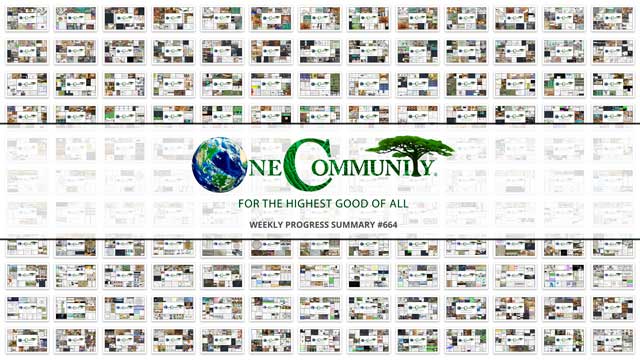
OUR MAIN OPEN SOURCE HUBS
Click on each icon to be taken to the corresponding Highest Good hub page.
One Community’s physical location will forward this movement as the first of many self-replicating teacher/demonstration communities, villages, and cities to be built around the world. This is the December 8, 2025 edition (#664) of our weekly progress update detailing our team’s development and accomplishments:
Adaptable Eco-models for Social Evolution
One Community Progress Update #664
DONATE | COLLABORATE | HELP WITH LARGE-SCALE FUNDING
CLICK HERE IF YOU’D LIKE TO RECEIVE AN EMAIL EACH WEEK WHEN WE RELEASE A NEW UPDATE
YOU CAN ALSO JOIN US THROUGH SOCIAL MEDIA
ONE COMMUNITY WEEKLY UPDATE DETAILS
HIGHEST GOOD HOUSING PROGRESS
 One Community is creating adaptable eco-models for social evolution through Highest Good housing that is artistic and beautiful, more affordable, more space efficient, lasts longer, DIY buildable, and constructed with healthy and sustainable materials:
One Community is creating adaptable eco-models for social evolution through Highest Good housing that is artistic and beautiful, more affordable, more space efficient, lasts longer, DIY buildable, and constructed with healthy and sustainable materials:
- Learn about: Our Upcoming Crowdfunding Campaign
- Learn about the different village models: 7 Sustainable Village Models
- Visit the open source portals for the first two: Earthbag Village OS Hub | Straw Bale Village OS Hub
This week, Ajay Adithiya Kumar Elancheliyan Tamilalagi (Mechanical Engineer) continued working on the ventilation system design for the Vermiculture Toilet component of the Earthbag Village. He collaborated with the team on Unistruct simulations and calculated values, completed HVAC CFD and FEA analyses based on those results, began drafting a report, created a bill of materials, organized drawings for potential HVAC components, and added those components to the working list while starting report preparation. His analytical progress supports adaptable eco-models for social evolution through the advancement of open-source HVAC design and integration. Below, you’ll find some images of this work.
Baraka Minja (Civil and Environmental Engineer Pr. Eng.) continued working on the Communal Eco-shower and Vermiculture Toilet drawings. He He worked on the Duplicable City Center foundation connection concept report, updating it with images to support the proposed connection methodology. Baraka also researched specialized connection drafting software to identify a platform capable of analyzing and drafting connections that meet construction standards in different countries. His contributions further adaptable eco-models for social evolution by enabling replicable and globally adaptable construction systems. See below for some of the pictures.
Derrell Brown (Plumbing Designer) continued working on the Earthbag Village 4-dome home final MEP report by reviewing feedback from the initial draft and applying updates across multiple sections. He reviewed the electrical section to begin integrating additional steps for determining conduit, feeder, and wire sizes, referencing NEC tables and charts to align the report with current design practices. Derrell also incorporated clearer procedures for sizing electrical equipment, including the water heater, heat pump unit, and fan coil units, ensuring each item reflected the appropriate calculations and code references. His detailed revisions contribute to adaptable eco-models for social evolution through improved accuracy and sustainable mechanical and electrical design. See below for some of the pictures related to this work.
Fangting Xu (Interior Design Intern) continued working with ADA codes related to building connections for the ADA 3-dome cluster of the Earthbag Village. She hosted the weekly meeting with Baraka and tracked his task progress. Fangting reviewed Jae’s feedback on the ADA checklist for the 3-dome cluster and developed the checklist further. She also requested the SketchUp file for the 3-dome cluster project to begin preparing the construction documents. Her commitment to accessibility and organization strengthens adaptable eco-models for social evolution by ensuring inclusive, standardized, and well-coordinated building documentation. See below for some of the pictures related to this work.
Malhar Solanki (Mechanical Engineer) continued working on the Vermiculture Toilet component of the Earthbag Village. He met with the team during the regular standup to discuss progress on CFD and FEA images and data, address questions related to report writing, and ensure alignment on ongoing tasks. Malhar also incorporated additional reference sources to strengthen the accuracy and support for various sections of the report. Work on the material selection section was completed as part of the ongoing documentation process, and the section assigned to him was nearly finished. The content was reviewed and discussed with Karthik to ensure consistency and clarity, and revisions were made based on the feedback received to improve the quality and structure of the written content. His technical writing and refinements advance adaptable eco-models for social evolution by improving collaboration and open documentation for sustainable engineering practices. Review the latest updates in the images below.
Rishi Chakrapani (Mechanical Engineer) continued working on the Vermiculture Toilet. He verified Joseph’s calculations for the force on the drawer and winch and completed the corresponding report. Rishi also finalized the sensor selection report and organized it for inclusion in the main project documentation. Additional time was spent developing the report for the dumping mechanism, focusing on the structural layout portion, which required performing both FEA and supporting calculations to evaluate the loads and confirm that the assembly meets the required design criteria. His efforts contribute to adaptable eco-models for social evolution by reinforcing accuracy, efficiency, and resilience in sustainable design systems. See below for some of the pictures related to this work.
DUPLICABLE CITY CENTER PROGRESS
 One Community is creating adaptable eco-models for social evolution through a Duplicable and Sustainable City Center that is LEED Platinum certified/Sustainable, can feed 200 people at a time, provide laundry for over 300 people, is beautiful, spacious, and saves resources, money, and space:
One Community is creating adaptable eco-models for social evolution through a Duplicable and Sustainable City Center that is LEED Platinum certified/Sustainable, can feed 200 people at a time, provide laundry for over 300 people, is beautiful, spacious, and saves resources, money, and space:
- Learn about this building and it’s function: Duplicable City Center Open Source Hub
This week, Ariana Virginia Gutierrez Doria Medina (Industrial Designer) continued working on the Duplicable City Center window and door framing window and door framing by completing the assembly manual, updating the list of parts, and preparing the cutting sheets, which included revising measurements and materials. She also made additional adjustments to close identified gaps to help maintain heat during cold weather and ensure the components aligned properly during assembly. Ariana’s work on this open source Duplicable City Center project demonstrates adaptable eco-models for social evolution. See the presentation and research highlights below.
Ayushman Dutta (Mechanical Engineer) continued working on the City Center Dome Hub Connector Engineering and DIY manufacturing. He reviewed the FEA analysis of the dome and created a feedback document outlining the needed adjustments, then worked on the row 4 Excel sheet diagrams by reviewing the related CAD model and applying the required changes. Ayushman also developed the row 4 CAD design and prepared assembly drawings for the spreadsheet. He completed the row 3 spreadsheet and its assembly drawings and met with the team to discuss roadblocks. Ayushman also prepared the first set of assembly drawings for the row 4 spreadsheet. This open source Duplicable City Center project demonstrates adaptable eco-models for social evolution. Review the connector analysis visuals below for more details.
Bevan Chiu (Mechanical Engineer Volunteer) continued his work finishing the City Center Eco-spa Designs. He assembled additional components of the CAD model, including the plumbing access panels and outer cinder blocks. Bevan also performed cost and weight calculations for the access panel materials and selected HDPE blocks and pressure-treated plywood based on project requirements. He expanded the mechanical room modeling by creating CAD representations of the blower, pump, heater, and associated pipe fittings. This open source Duplicable City Center project contributes to adaptable eco-models for social evolution. For more details, refer to the image below.
Sandesh Kumawat (Mechanical Engineer) continued developing the City Center Eco-spa Designs. He worked on the meshing phase for the Eco-Spa hot tub by preparing simulation-ready meshes for thin-walled and solid components in HyperMesh and ANSYS Mechanical. Sandesh applied shell meshes for the cork-plywood inner panels, Unistrut frame members, and steel plates, and created solid meshes for the cinder block foundation, concrete layer, and insulation using hexahedral and tetrahedral elements. He assigned the required contact interfaces between panels, frames, and connectors and organized the assembly by separating material groups for use in analysis. Sandesh also checked mesh quality using aspect ratio and minimum angle criteria to confirm stability for structural and thermal simulation. Discover One Community’s open source Duplicable City Center, which exemplifies adaptable eco-models for social evolution. See the visuals below for a closer look.
Shivarama Krishna Revanuru (Mechanical Engineer) continued working on the Duplicable City Center design. He completed the orientation and setup steps, responded within the orientation materials, reviewed the project files to understand the scope and context, and familiarized himself with his responsibilities and assigned tasks. Shivarama also spent time understanding the workflow and identifying key areas of focus within the team. This open source Duplicable City Center project exemplifies adaptable eco-models for social evolution. The images below illustrate aspects of this work.
Shreyas Nagaraj (Design Engineer) made more updates to the City Center Dome Hub Connector Engineering and beams for the Duplicable City Center. He clarified the division of tasks for the tub cover with a team member, drafted the dimensions of the spa tub to support the cover design, and prepared the initial design drafts and sketches. Shreyas also created documents outlining the materials for the spa hot tub design and the spa cover product, and he joined a meeting with the hot tub team to discuss project needs. This open source Duplicable City Center project exemplifies adaptable eco-models for social evolution. For more details, refer to the image below.
Srujan Pandya (Mechanical Engineer) continued his work on developing the dynamic simulation setup for earthquake analysis updates for the City Center Dome Hub Connector Engineering. He aligned the dome models with the DWG, CAD, and SketchUp references by listing all parts, identifying removed elements, and confirming that the totals matched across the three domes. Srujan also updated the review integration sheet, verified the files shared by Jae to support accurate calculations for parts removal, and shared the integrated updates with Jae and the team to keep the documentation current. The Duplicable City Center demonstrates adaptable eco-models for social evolution through open source solutions that can guide people. The images below illustrate aspects of this work.
Tianxiang Huang (Mechanical Engineer) continued working on the Duplicable City Center design. He prepared the thermal analysis document and highlighted the need to improve insulation at the tub corners where heat loss is highest. Tianxiang also calculated the R-value using the area and temperature distribution to evaluate current performance and reviewed the setup used to model heat convection in the study. This open source Duplicable City Center project exemplifies adaptable eco-models for social evolution. For more details, refer to the image below.
HIGHEST GOOD FOOD PROGRESS
 One Community is creating adaptable eco-models for social evolution through Highest Good food that is more diverse, more nutritious, locally grown and sustainable, and part of our open source botanical garden model to support and share bio-diversity:
One Community is creating adaptable eco-models for social evolution through Highest Good food that is more diverse, more nutritious, locally grown and sustainable, and part of our open source botanical garden model to support and share bio-diversity:
- Learn about the structures: Hoop House Hub | Aquapini & Walipini Open Source Hub
- See what we’ll be growing: Gardens & Hoop Houses | Large-scale Structures | Food Forest | TA
This week, the core team continued working on the Master Tools, Equipment, and Materials and Supplies List for the Large-scale Garden, Botanical Garden, and other Highest Good Food components. The team completed comparisons between the Earthbag Village (EBV) and Tropical Atrium (TA) documents. They then compared the Master document with the EBV document and initiated the Food Forest (FF) Tools, Equipment, Materials/Supplies (TEMS) list by cross-referencing the acronyms on the Master TEMS list, RAB and CHICK docs, the MASTER and SA doc, and the Master and EBV doc. The team decided that the APY doc would not be included in the Master doc and would exist as its own document. The Highest Good Food initiative is a key component of One Community’s open source plans, focused on adaptable eco-models for social evolution and exemplifying the organization’s commitment through innovative design and implementation. Below are some images showcasing this work.
Anuneet Kaur (Administrator) continued her focus on the design of the Transition Food Self-sufficiency Plan components of the Highest Good food initiative. She continued working on the Customizable Recipe Build-Out Tool and completed the food self-sufficiency transition plan webpage. Anuneet integrated Jae’s feedback and completed the Transition Kitchen, Vegan Pasta, and Omnivore Pasta webpages. She ensured that each page followed the updated formatting guidelines, corrected inconsistencies, and optimized all links for SEO across the recipe sections. Anuneet also reviewed titles, spacing, and layout alignment to maintain uniformity throughout the Food Web project. Additionally, she ensured all team members were included in the live blog task and identified anyone who was missing. Anuneet reviewed Yulin’s infographic on sustainable research and provided detailed feedback. She fulfilled administrative responsibilities by editing summaries and collages for the Highest Good Society, Highest Good Education, and Core Teams, and reviewed fellow admin submissions for completeness and accuracy. Her work contributes to adaptable eco-models for social evolution. Below are some images showcasing her work.
Chelsea Mariah Stellmach (Project Manager) continued working on the Transition Food Self-sufficiency food and inventory tracking software plans. She addressed a miscommunication with Ravi and then reviewed his new mockup designs in Figma. She addressed a miscommunication with Ravi and then reviewed his new mockup designs in Figma. Chelsea consulted with Jae regarding the project status and gathered feedback on the existing designs. She organized all current mockups into a single, easy-to-use Dropbox folder and outlined the structure of a document to guide the software engineering team, with the intention of completing it next week. As an essential aspect of One Community’s open source goals, the Highest Good Food initiative supports adaptable eco-models for social evolution. The following images provide a view of her contributions.
Gayatri Pandkar (Architect) continued writing content for the various components of the Aquapini and Walipini aspects of the Highest Good Food initiative. She researched suitable plants and trees to incorporate into the Walipini 3 structure, added these selections to the SketchUp model, and refined placement to align with the planned layout. Gayatri also began developing the concept for the people space, focusing on initial spatial organization and how the added vegetation would influence circulation, usability, and overall integration within the design. The Highest Good Food initiative is a key part of One Community’s open source platform, focused on sustainable, participatory development, and adaptable eco-models for social evolution. Visual examples from her work are presented below.
Japneet Kour (Volunteer Architect) continued contributing to the Highest Good Food initiative. She made updates to the renders and walkthrough of Walipini #1, the Frost-Free Arid Zone Desert House, including adjustments to the depiction of desert lichens, the addition of a fruit tree, the inclusion of more plants, the refinement of external details, and the creation of a walkthrough that begins from the outside. Japneet also reviewed the large set of files for Walipini 3, identified the external structure needed for upcoming work, and examined the layout and species to be included based on the information in the report. The Highest Good Food initiative is a key part of One Community’s open source platform, focused on sustainable and participatory development while supporting adaptable eco-models for social evolution. Visual examples from her work are presented below.
Jay Nair (BIM Designer) continued developing the Aquapini and Walipini Planting and Harvesting documents. Jay worked on the lighting energy calculation for Walipini 1 and continued standardizing the format of the document to align with project requirements. He reviewed the structure, updated sections for consistency, and organized the information for clearer presentation. Jay also spent time brainstorming ideas for the lighting energy calculator, outlining possible functions and approaches that could support future calculations. The Highest Good Food initiative is a key part of One Community’s open source platform, focused on sustainable and participatory development while supporting adaptable eco-models for social evolution. See below for pictures related to this work.
Nitin Parate (Architect) continued contributing to the Aquapini and Walipini renders and layout graphics. His work on the Walipini tasks continued, beginning with preparing the base file for the Walipini 2 section and initiating the rendering process. Nitin focused on establishing the structural layout needed for accurate detailing and organizing the visual layers required for further development. He also worked on rendering updates to align the section with overall design and project requirements. The Highest Good Food initiative is a key part of One Community’s open source platform, promoting regenerative and participatory development while supporting adaptable eco-models for social evolution. Images below showcase his contributions.
Pallavi Deshmukh (Software Engineer) continued working on the Aquapini and Walipini Planting and Harvesting web details. She completed five interviews and submitted the required details. Pallavi continued adding Walipini 1 and Zenapini 1 content from Gayatri’s work and incorporated that material into the Aquapini and Walipini Planting and Harvesting page. She worked on editing images based on the specified requirements so they could be included on the page, reviewed the full page using Jae’s feedback, and submitted it for review. Pallavi also created new content for blog 663 and collaborated with her teammates by reviewing their suggestions and incorporating feedback to maintain a consistent and clear final version. In alignment with One Community’s open source objectives, the Highest Good Food project integrates adaptable eco-models for social evolution into a larger vision of regenerative living. Her contributions are highlighted in the collage below.
Ravi Kumar Sripathi (Software Engineer) continued developing the Food Procurement and Storage software platform, enhancing features related to inventory tracking, recipe management, and food utilization. He refined the inventory management system by updating the design layout and creating new wireframes that incorporate Update Stock and Reorder functions to support stock adjustments and reorder actions. Ravi also added new pages and wireframes for equipment supplies, canning supplies, seeds, and animal supplies to improve organization across inventory categories. He worked on the Phase 5 UI/UX design document by outlining the structure, components, user flows, and interface requirements needed for the next stage of development. The Highest Good Food initiative is a key part of One Community’s open source platform, focused on sustainable and participatory development while supporting adaptable eco-models for social evolution. See below for pictures related to this work.
Shivangi Varma (Architectural Designer and Planner) continued the redesign of the Highest Good Food overall presentation, currently focused on the Aquapini and Walipini masterplan render. She updated the materials for the Walipini and Zenipini layouts, incorporated the layout prepared by the architect volunteer into the masterplan render, and coordinated with the volunteer on pending tasks and graphics for the HGF Infrastructure page and Open Source Hub page. Shivangi also continued incorporating the updated PNGs of trees and plants from the Planting and Harvesting page’s planting list. The Highest Good Food initiative plays a leading role in One Community’s open source platform by promoting sustainable and participatory development, focused on adaptable eco-models for social evolution. Below are visuals highlighting this work.
HIGHEST GOOD ENERGY PROGRESS
 One Community is creating adaptable eco-models for social evolution through Highest Good energy that is more sustainable, resilient, supports self-sufficiency and includes solar, wind, hydro and more:
One Community is creating adaptable eco-models for social evolution through Highest Good energy that is more sustainable, resilient, supports self-sufficiency and includes solar, wind, hydro and more:
- Learn about the open source sustainable-energy foundations: Solar, Hydro, and Wind
- Explore our research into the most sustainable products and companies for saving water and energy: Insulation, Eco-laundry, Lightbulbs and Light Bulb Companies, Doors and Door Companies, Windows and Window Companies, Toilets, Faucets and Faucet Accessories, Urinals, and more.
This week, the core team continued contributing to the Highest Good Energy initiative. They watched the feedback video on the Climate Battery document, read through the entire document, made the suggested changes, added comments identifying the location of each new image, adjusted formatting, and corrected minor errors. The team also spent time reviewing the pages on the most sustainable paint, urinals, lighting, and insulation. The Highest Good Energy initiative plays a leading role in One Community’s open source platform by promoting sustainable and participatory development, focused on supporting adaptable eco-models for social evolution. Below are images related to this project.
HIGHEST GOOD EDUCATION PROGRESS
 One Community is creating adaptable eco-models for social evolution through Highest Good education that is for all ages, applicable in any environment, adaptable to individual needs, far exceeds traditional education standards, and more fun for both the teachers and the students. This component of One Community is about 95% complete with only the Open Source School Licensing and Ultimate Classroom construction and assembly details remaining to be finished. We’ll report on the final two elements to be finished as we develop them.
One Community is creating adaptable eco-models for social evolution through Highest Good education that is for all ages, applicable in any environment, adaptable to individual needs, far exceeds traditional education standards, and more fun for both the teachers and the students. This component of One Community is about 95% complete with only the Open Source School Licensing and Ultimate Classroom construction and assembly details remaining to be finished. We’ll report on the final two elements to be finished as we develop them.
With over 8 years of work invested in the process, the sections below are all complete until we move onto the property and continue the development and open sourcing process with teachers and students – a development process that is built directly into the structure of the education program and everything else we’re creating too:
- Program Overview: Education Open Source Hub
- How the components work together in designing human orchestrated eco-abundance: How to use the Education for Life Program
- Lesson Plans for Life – Lesson Plans How-to
- Foundations of Outstanding Leaders, Teachers, and Communicators
- Curriculum for Life
- Teaching Strategies for Life
- Learning Tools and Toys for Life
- Evaluation and Evolution
This week, Prudhvi Marpina (Data Analyst) continued developing the Highest Good Education software platform, concentrating on Phase 4: marketing, promotion, and administrative activities. He worked on HGN Software Development, Marketing and Promotion, and OC Administration tasks. In Phase 4 Software Management, Prudhvi reviewed action items, checked open pull requests, confirmed which items were ready to merge, assigned tasks requested by developers, and messaged developers and reviewers on Slack to help resolve conflicts in deliverable items. He also looked over progress for Level 1 and Level 2 testing to see which items still needed attention. For Marketing and Promotion, he updated the BlueSky analytics dashboard with weekly and daily data and organized this week’s post schedule with the planned content. In OC Administration, he reviewed weekly summaries from the administration team and updated the blog for the current week. Through these activities, he supported One Community’s commitment to adaptable eco-models for social evolution. The images below highlight his contributions.
HIGHEST GOOD SOCIETY PROGRESS
 One Community is creating adaptable eco-models for social evolution through a Highest Good society approach to living that is founded on fulfilled living, the study of meeting human needs, Community, and making a difference in the world:
One Community is creating adaptable eco-models for social evolution through a Highest Good society approach to living that is founded on fulfilled living, the study of meeting human needs, Community, and making a difference in the world:
- Read the Highest Good society overview: Highest Good Society
- Learn about the model for fulfilled living and sharing: A Day in the Life
- Learn about the 4 economic models: RBE | For-profit | Non-profit | Entrepreneurship
- Learn about our open source community collaboration and management software: The Highest Good Network
This week, the core team completed over 34 hours managing volunteer work reviews, handling emails, overseeing social media accounts, supporting web development, identifying new bugs, and integrating bug fixes for the Highest Good Network The team also interviewed and onboarded new volunteer team members. Additionally, they produced and integrated the video above, which highlights how adaptable eco-models for social evolution serve as the foundation of One Community’s broader mission. The following images showcase highlights of this work.
Jaiwanth Reddy Adavalli (Project Manager) continued developing the Job Applicants page and key components of the Highest Good Network. He tested multiple pull requests for components in various parts of the HGN Software, including the Application page and dashboards for Phases 1, 2, and 3. Jaiwanth created new action items to develop additional components and met with Rajrajeshwari to discuss new features and finalize the Phase 2 dashboard action items. He tracked updates in software team management documents to support task management. As a member of the pull request review team, Jaiwanth reviewed submissions from the volunteer team assigned to him. This work supports One Community’s commitment to adaptable eco-models for social evolution. The images below highlight his contributions.
Rajrajeshwari Gangadhar Sangolli (Data Analyst) continued working on Google Ads management and strategy evolution of the Highest Good Network. She completed her admin work for 11 volunteers. Rajrajeshwari also reviewed errors with GPT, launched nine new ad groups with keywords, headlines, descriptions, and images for the food campaign based on instructions, and added three new tasks after the format was approved. Updates were made to both the document and the spreadsheet using bookmarks. She produced seven new charts for further approval and ideated chart concepts for the dashboard. Rajrajeshwari added one new task to the sheet and another chart to the dashboard page. Approval for all designs was received, and she coordinated with Jaiwanth regarding design and task details. This project supports One Community’s commitment to adaptable eco-models for social evolution. The images below highlight key aspects of her work.
ADMINISTRATION TEAM
The Administration Team’s summary, which covers their work on the Highest Good Network, was managed by Prudhvi Marpina (Data Analyst) and includes Anusha Gali (Software Engineer), Ashutosh Mishra (Software Engineer), Divanshu Bakshi (Team Admin), Indra Anuraag Gade (Software Engineer and Team Administrator), Keerthana Chitturi (System Administrator), Neeharika Kamireddy (Data Analyst), Olawunmi “Ola” Ijisesan (Administrative and Management Support), Olimpia Borgohain (Data Analyst and Team Administrator), Priyanshi Sharma (Data Analyst and Team Administrator), Rajeshwari Bhirud (Administrator), Rishi Sundara (Quality Control Engineer and Team Administrator), Rishitha Adepu (Administrator), Sai Suraj Matta Veera Venkata (Business Data Analyst), Sayantan Paul (Volunteer Frontend Tester and Software Team Administrator), and Sudarshan Raju Chintalapati Venkata (Data Analyst). The Administration Team supports the Highest Good Network, a tool designed to track and measure progress while developing systems that contribute to adaptable eco-models for social evolution. Through administrative support, documentation, testing, training, recruiting, analytics, and content management, the team helps advance this mission, aligning with One Community’s vision of building a replicable and sustainable future model.
This week, Anusha continued Level 2 testing across the HGN system by validating frontend and backend pull requests and addressing UI, permissions, dark mode, and data-filtering issues. She also supported administrative workflows through summary checks, collages, and blog updates. Ashutosh advanced multimodal development by migrating LCEL chains into LangGraph, separating audio and video processing flows, exploring token-queue optimizations, redesigning the wireframe structure, and refining distributed routing for agentic processing. Divanshu documented daily Mastodon posts, processed analytics with Python, refreshed the master dataset, and verified updated dashboard metrics. Indra prepared the Code Crafters Team blog update, reviewed multiple pull requests, added new tasks, updated tracking systems, and expanded data labeling for machine-learning workflows. Keerthana reviewed summaries, updated Step 2 and Step 4 documentation, prepared the weekly blog, and added Phase 3 action items. This work supports One Community’s exploration of adaptable eco-models for social evolution.
Neeharika coordinated software team tasks by reviewing management documents, following up on assignments, testing pull requests, reviewing admin work, and logging new tasks while completing her weekly administrative responsibilities. Ola analyzed Pinterest analytics, confirmed engagement-rate reporting accuracy, and updated administrative folders to streamline team workflows. Olimpia updated LinkedIn analytics KPIs, completed senior-admin review checks, resolved documentation comments, managed warnings and blue-square notifications, and prepared next week’s scheduled content. These efforts continue supporting adaptable eco-models for social evolution.
Priyanshi validated chart behavior, filter interactions, and layout consistency across multiple sections of the platform while documenting all Phase 2 testing findings. Rajeshwari tested BM Dashboard modules, reviewed summaries, updated SEO keywords, refined WordPress content, and completed tracking updates for Weekly Progress #663. Rishi reviewed pending and completed pull requests, tested merge-conflict updates, coordinated with contributors on Slack, added priority labels, and merged individual blogs into Blog #663 with SEO updates. Rishitha optimized the combined blog, updated bios, uploaded Threads content, added raw data to the Social Media Master Dashboard, and updated the volunteer tracker. This effort advances One Community’s commitment to adaptable eco-models for social evolution.
Sai Suraj extracted performance data from Meta platforms, refreshed analytics dashboards, updated raw data structures, scheduled content, authored workflow guides, organized digital assets, refined SEO-aligned pages, compiled team summaries, and prepared weekly reporting materials. Sayantan validated merged pull requests across multiple components, confirmed fixes, identified UI and dark-mode alignment issues, documented dashboard behavior, and submitted the Skye Team update. Sudarshan managed the Alpha Software Team blog through content updates, SEO improvements, collages, and multi-component testing, creating new tasks and validating dashboard updates. To learn more about how this work supports adaptable eco-models for social evolution, visit the Highest Good Society and Highest Good Network pages. Highlights of the team’s contributions are shown in the collage below.
GRAPHIC DESIGN TEAM
The Graphic Design Team’s summary includes Qinyi Liu (Graphic Designer) and Yulin Li (Graphic Designer), who focused this week on creating graphic designs that support adaptable eco-models for social evolution.
This week, Qinyi worked on marketing and promotion tasks by creating and updating social media images, bio images, website announcements, and character-based visuals aligned with adaptable eco-models for social evolution, while uploading required assets and maintaining consistency across materials. Yulin created announcements, managed assets in Dropbox, participated in review discussions, and aligned part of her work with adaptable eco-models for social evolution. Their combined efforts highlight adaptable eco-models for social evolution. Highest Good Society pages and the collage below for examples of their work.
HIGHEST GOOD NETWORK PROGRESS
 One Community is creating adaptable eco-models for social evolution through open source Highest Good Network® software that is a web-based application for collaboration, time tracking, and objective data collection. The purpose of the Highest Good Network is to provide software for internal operations and external cooperation. It is being designed for global use in support of the different countries and communities replicating the One Community sustainable village models and related components.
One Community is creating adaptable eco-models for social evolution through open source Highest Good Network® software that is a web-based application for collaboration, time tracking, and objective data collection. The purpose of the Highest Good Network is to provide software for internal operations and external cooperation. It is being designed for global use in support of the different countries and communities replicating the One Community sustainable village models and related components.
- Learn about our open source community collaboration and management software: The Highest Good Network
This week, the core team tested HGN pull requests and confirmed 18 as fixed. This effort highlights One Community’s commitment to adaptable eco-models for social evolution.
The following PRs were not fixed: Badge Data Not Displayed on Summary Page, alignment and dark mode issues in TotalOrgSummary, and the fix for the hours completed bar chart. They also reported a new bug related to correcting the Active/Inactive icon color in Dark mode on the Profile page and the User Management page. This work strengthens One Community’s mission of adaptable eco-models for social evolution. See the Highest Good Society and The Highest Good Network pages, and the collage below, for an overview of the team’s contributions.
ALPHA SOFTWARE DEVELOPMENT TEAM
The Alpha Software Team, working on the Highest Good Network software, was managed by Lin Khant Htel (Frontend Software Developer). The team includes Nikita Kolla (Full Stack Developer). The Highest Good Network software is a key part of sustainable and free-shared eco-solutions, helping track and measure progress toward adaptable eco-models for social evolution. The software supports social architecture, construction, production, and maintenance processes that contribute to the open source project and resilient ecosystems. Designed to be portable and scalable, the Highest Good Network software is well suited for off-grid and sustainable living communities. This project reflects One Community’s open source commitment to adaptable eco-models for social evolution.
This week, Nikita completed administrative work by connecting tasks in the HGN app to GitHub pull requests and resolving merge issues for the “Create Weekly Company Summary Email for Admins” task. She ensured the contents of the routes.js file were correctly moved to the routes.jsx file in alignment with current development standards, with the code passing all necessary tests for merge. Nikita then worked on the task “Add Inventory Health Indicators and Summary Cards for Materials,” reviewing the existing code and problem description, confirming the required components, and outlining her initial approach before beginning implementation. See the Highest Good Society and Highest Good Network pages for more on how this contributed to adaptable eco-models for social evolution. See the collage below to view the team’s work.
BINARY BRIGADE SOFTWARE DEVELOPMENT TEAM
The Binary Brigade Team, presenting their work on the Highest Good Network software, was managed by Nikhil Routh (Software Engineer) and included Kanishk Agarwal (Software Engineer), Apoorva Jain Ramapura Prashanth (Software Engineer), Harsha Rudhraraju (Software Engineer), Taariq Mansurie (Full-Stack Developer), Sourabh Bagde (Software Developer), Sumedh Kumar (Full-Stack Developer), Ramsundar Konety Govindarajan (Software Engineer), Deep Shah (Software Engineer), Aswin “Tony” Kanikairaj (Software Engineer), and Amalesh Arivanan (Software Engineer). The Highest Good Network software is our tool for managing and objectively measuring progress, ensuring that all contributions are tracked and aligned with our mission, modeling, and adaptable eco-models for social evolution.
This week, Amalesh improved the mismatched team codes functionality on the Weekly Team Summaries page by updating the comparison logic to use only the last three digits of each code, adding a filter triggered by the red icon to show only mismatched entries, updating the mouseover text, testing the changes, and uploading documentation. Apoorva worked on the MailChimp replacement system by redesigning the EmailOutbox layout, improving the IntegratedEmailSender interface, updating the EmailTemplateEditor and EmailTemplateList, creating documentation for lost templates, adding administrative tools for processing stuck emails, implementing diagnostic logging to trace frontend-to-backend issues, identifying authentication errors, centralizing constants, converting state management to useReducer, and addressing remaining security problems. This work supports One Community’s mission to create adaptable eco-models for social evolution.
Aswin integrated the grouped bar graph for Injury Severity by Projects into the Total Construction Dashboard, added a display card, aligned the component with existing structures, updated the toggling logic, refined dark-mode styling, resolved selector conflicts, standardized color variables, and verified responsiveness across devices. Deep fixed dark mode issues in the BM Dashboard Materials table header, resolved redundant tag creation in the lesson form, corrected legend visibility problems in the Rental Cost Over Time chart, added equipment detail rendering via backend APIs, and created corresponding pull requests. Harshavarma reviewed backend API responses for event attendance, drop-off rates, and no-show data; fixed event-rendering issues; began integrating new endpoints into cards, list views, and calendar tabs; added filters and error handling; implemented reducers and actions for data fetching; validated endpoint structures; and worked on responsiveness and consistent UI behavior. This work advances One Community’s focus on adaptable eco-models for social evolution.
Kanishk completed Phase 3 tasks, including Event Popularity Analytics visualizations, backend metric endpoints, calendar view functionality, Create New button behavior, event image fixes, estimated value display, and dark mode updates on Participation Reports; he also fixed linting errors, resolved merge conflicts for the Registration Status feedback and Bios criteria PRs, and incorporated community review comments. This effort aligns with One Community’s goal of developing adaptable eco-models for social evolution. Nikhil continued the CSS Modules migration across Activity details, the Activity Dashboard, and Teams components by converting files, updating imports, fixing class mappings, reviewing related PRs, validating behavior, and coordinating tasks; he also clarified backend requirements with a teammate, outlined data flow and database changes for a new feature, assisted with a Phase III task, and raised a backend-related question. This contribution strengthens One Community’s commitment to adaptable eco-models for social evolution. Ram fixed a page crash on the Lessons Learnt bar chart by replacing placeholder API endpoints with correct backend routes, adding authentication token handling, implementing error handling, restoring chart rendering and dropdown population, and recording a verification video before submitting the PR. Sourabh updated the MySpace auto-poster to align with the blog form by adding category defaults and optional fields, reshaping copy and validation logic, updating previews and scheduling behavior, fixing copy buttons and hints, and creating a PlatformScheduleBadge module used across MySpace interfaces to track schedule counts. This progress reflects One Community’s dedication to adaptable eco-models for social evolution. Taariq resolved merge conflicts across multiple branches, progressed lesson plan table updates, investigated archived project issues, reviewed weekly summary email logic, addressed filter-related breakages, debugged auto-scroll and caching issues in the BioStatusToggle, validated fixes, and coordinated frontend and backend updates. See the Highest Good Society and Highest Good Network pages for more information on how this work models adaptable eco-models for social evolution. The collage below shows images of their work.
BLUE STEEL SOFTWARE DEVELOPMENT TEAM
The Blue Steel Software Team, working on the Highest Good Network software, was managed by Divanshu Bakshi (Product Manager), and includes Linh Huynh (Software Engineer), Som Ramnani (Software Engineer), and Sheetal Mangate (Software Engineer). This week, Linh worked on the educator task-submission feature across both the backend and frontend by correcting incorrect assumptions in the previous implementation, updating the API contract, adding the missing studentId field to the backend response, adjusting filtering logic, and validating authentication issues caused by mismatched token formats. He updated the backend route to handle query-based filtering, aligned the frontend grouping logic with the revised payload structure, resolved inconsistencies between browser and Postman authorization headers, validated late-submission behavior, and confirmed that expandable task sections displayed accurate counts. As part of the team’s ongoing effort to create processes that support adaptable eco-models for social evolution, he prepared updated pull-request titles for both repositories, completed conflict-resolution steps, and reviewed backend unit-test behavior by comparing GitHub Actions coverage failures with passing results in the local environment.
Som worked on completing PR#4228 by resolving merge conflicts across the branch, including dependency-related conflicts in package-lock.json, and rebasing the feature branch onto the latest development changes while regenerating the lockfile for consistency. This work furthers One Community’s vision of adaptable eco-models for social evolution. He resolved additional merge conflicts involving the DatePicker component, aligned it with recent CPDashboard layout updates, removed inline styling, and migrated all styling into CPDashboard.module.css to follow project conventions. Som cleaned up the branch with a force-push, updated the pull-request description, and submitted it for review. He also investigated a backend MongoDB connection issue by reviewing server logs, identifying a MongoParseError linked to a missing or incorrectly formatted MONGO_URI variable, adding debugging output to verify environment loading, checking the .env configuration, and confirming that Mongoose could not establish a connection, resulting in query timeouts. This effort helps build One Community’s framework of adaptable eco-models for social evolution. Sheetal managed the weekly summary, analyzed task requirements for new security measures, evaluated how these updates could apply to the Reddit autoposter and other autoposter services, created a new branch for the work, explored the Bitwarden SDK to retrieve secrets from the vault while identifying limitations in locating certain entries, and reviewed the Bitwarden CLI to determine how it could be used to access Bitwarden Vault APIs, contributing to smoother workflows that align with adaptable eco-models for social evolution. The collage below shows images of their work.
CODE CRAFTERS SOFTWARE DEVELOPMENT TEAM
The Code Crafters Team, covering their work on the Highest Good Network software, was managed by Vivek Chandra (Software Engineer) and includes Ajay Naidu (Software Engineer), Akshith Kumar Reddy Balappagari Gnaneswara (Software Engineer – Full Stack), Chaitanya Swaroop Kumar Allu (Software Engineer), Juhitha Reddy Penumalli (Software Engineer), Shradha Bhadrannavar (Software Engineer), Sphurthy Satish (Software Engineer). The Highest Good Network software is how we’ll manage and objectively measure our progress in developing adaptable eco-models for social evolution through our social architecture, construction, production, and maintenance efforts, while supporting widespread and lasting eco-lifestyle access.
This week, Ajay improved chart and form consistency by standardizing colors across themes, aligning data label placement for readability, synchronizing input and select control styles, and validating these updates through local testing in both light and dark modes. This effort helps build One Community’s framework of adaptable eco-models for social evolution. Akshith advanced the Phase 4 Individual Student Report Generation backend by creating the controller and router, implementing methods for calculating grade, progress, and performance statistics, completing and testing a report-generation endpoint, and reviewing the remaining requirements for the export feature. Chaitanya contributed to the MailChimp Replacement by testing new frontend functionality, resolving bugs, refining backend code, preparing a detailed PR, and creating a new weekly template, while also improving the Phase 2 Lesson Data Export feature through UI updates, CSS refinements, code cleanup, added failure-prevention handlers, and extensive testing. Juhitha worked across the Project Status Donut Chart and Resource Management Dashboard by fixing date-handling and dark-mode issues, resolving merge conflicts, stabilizing validation logic, debugging routing problems, adding missing paths, completing dashboard-tab development, and conducting full end-to-end testing before preparing the PR. This work plays a role in One Community’s pursuit of adaptable eco-models for social evolution.
Shradha addressed report issues tied to PR#3668 and PR#1476 by reproducing failures in the Total People and Total Project reports, introducing logging to trace API payloads and date calculations, examining chart-rendering conditions, refining thresholds and filters so charts render correctly for valid ranges, and completing regression testing across all report buttons in light and dark modes. This contribution supports One Community’s approach to adaptable eco-models for social evolution. Sphurthy resolved dark-mode visibility concerns on the Participation page by adding new CSS variables and updating dropdowns, event-card elements, category badges, count badges, borders, table cells, insights text, and insights tabs to ensure proper contrast and consistent styling. Vivek focused on diagnosing communication failures between the frontend and backend API by reviewing how requests were structured, validating environment configurations, analyzing routing and middleware behavior, testing multiple points in the request flow to pinpoint where responses were breaking down, and reviewing all team submissions while continuing to investigate the connectivity issue. These contributions strengthen One Community’s mission and commitment in developing adaptable eco-models for social evolution. The collage below shows an overview of this team’s work.
DEV DYNASTY SOFTWARE DEVELOPMENT TEAM
The Dev Dynasty Team’s summary, covering their work on the Highest Good Network software, was managed by Prem Vora (Software Developer) and includes Adithya Cherukuri (Volunteer Software Engineer), Aditya Gambhir (Software Engineer), Deekshith Kumar Singirikonda (Developer), Manvitha Yeeli (Software Engineer), Nahiyan Ahmed (Full-Stack Software Developer), Sriamsh Reddy (Software Engineer), Neeraj Kondaveeti (Software Engineer) and Vamsidhar Panithi (Software Engineer). The Highest Good Network software is how we’ll manage and objectively measure our processes for open sourcing a better world for us all through our social architecture, construction, production, and maintenance processes. This progress supports One Community in adaptable eco-models for social evolution.
This week Nahiyan reviewed PR 4512 to verify updates to dark and light mode styling for table headers, calendars, and time list components, checking backgrounds, text colors, and state behaviors to ensure consistency with the intended design. This work supports One Community’s mission to create adaptable eco-models for social evolution. Adithya focused on the HGN Software Development project by continuing work on Phase 2 of the Edit Existing Team redirect, building the ProjectTeams component to map raw team data for display, integrating the Edit Team popup with modal state logic, connecting the modal to the backend to save updates, adding input validation for team names, refining error handling, and preparing his weekly summary. This work advances One Community’s focus on adaptable eco-models for social evolution. Aditya worked on the Paid Labor Cost feature for the Building Management Dashboard, implementing a new backend controller with validation, query parsing, aggregation logic, and tests, updating the frontend chart with filtering, date handling, state separation, and layout adjustments, improving dark mode support and CSS modularity on the Total Org Summary page, analyzing the Material Usage Dashboard routing issue and identifying the missing backend endpoint, refining responsive behavior and styling for the Tools and Equipment Tracking section, and reviewing Paid Labor Cost chart updates and Community Portal dark mode changes. This effort aligns with One Community’s goal of developing adaptable eco-models for social evolution. Deekshith prepared the front-end structure for issue-related dashboards by organizing sample data for charts, defining light and dark mode styles through a CSS module, and building a React component that manages header behavior, state, profile data, and project fetching.
Manvitha resolved a backend MongoDB connection issue by migrating to the mongodb+srv format, fixed dark mode inconsistencies, updated the FAQ search and admin workflows, completed backend updates for the Educator–PM Resource Request feature with schema changes, authorization controls, validation, pagination, and revised unit tests, and submitted the updates in PR 1940. This work furthers One Community’s vision of adaptable eco-models for social evolution. Neeraj updated several community portal components by adding an Amount label and extending material bar categories on the Resources Usage chart, improving dark mode readability on the Most Popular Event page, adjusting styling tokens, reviewing UI alignment with design files, and preparing related pull requests. Prem focused on PR review work for the HGN Software Development project, reviewing multiple PRs across feature updates, UI changes, expected behavior, and testing outcomes, documenting observations and confirming alignment with project requirements. Sriamsh implemented the Project Status Donut Chart for the BM Dashboard by creating new components and styles, integrating the feature with filters and loading states, validating backend behavior, checking authorization flow, testing data responses, confirming endpoint accuracy, reviewing rendering with real and mock data, resolving caching issues, and preparing the frontend for PR submission. Vamsidhar addressed dark mode styling issues across Materials Management pages by adjusting base color rules, adding dark mode-specific styles for tables, inputs, dropdowns, and placeholders, updating React-Select behavior with Redux-based styling logic, applying similar fixes across inventory pages and modals, removing outdated global CSS, verifying the updates through testing, and committing the changes to the dark mode update branch. See the Highest Good Society and Highest Good Network pages for more on how this relates to our mission of adaptable eco-models for social evolution. Explore some of the team’s work in the collage below.
EXPRESSERS SOFTWARE DEVELOPMENT TEAM
The Expressers Team’s summary, which covers their work on the Highest Good Network, was managed by Rahul Trivedi (Software Engineer) and includes Casstiel Pi (Software Engineer), Layne Taylor (Software Engineer), and Meenashi Jeyanthinatha (Full-Stack Developer). This effort supports One Community’s goal of creating adaptable eco-models for social evolution.
This week, Casstiel continued working on the clicking error related to the lesson box and resolved it by identifying and updating a deprecated package that caused the issue. After implementing the fix, a new error was found where text became invisible when dark mode was enabled. This was addressed by updating the CSS to support dark mode styling. Casstiel also started a new task focused on enhancing the filter and tag selection features. This work directly contributes to One Community’s mission of developing adaptable eco-models for social evolution. Layne focused on reviewing the code base to understand the existing redux flow and the file she is working with, including a comment indicating that form data should be validated and submitted to the API, which she believes may have been left in by mistake. She determined that she spent more time than planned trying to interpret the backend and redux logic, so she created a basic SKU generator that triggers on the submit button and currently logs output to the console. She was not able to allocate the amount of time she intended, so she will complete additional hours on Saturday after submitting her summary. She plans to connect with Jae regarding how the numeric portion of the SKU should be structured, as it is currently generated with a random number. She aims to add functionality that allows the SKU to be generated, reviewed or edited by the user, approved, and incorporated into the form data. This will require separating the SKU input from the formData state, capturing it when the generate button is used, and passing it into formData during submission. She plans to address this work on Saturday and continue it next week, and she is also preparing information needed for her bio on the website. This work directly contributes to One Community’s goal of developing adaptable eco-models for social evolution.
Meenashi added validations to the Jobs POST API to ensure that category, position, description, requirements, projects, and community fields meet required rules and minimum word counts aligned with the front end, and also confirmed that the applyLink fields are present in job forms. Meenashi noted that the related front-end collaboration work did not introduce structural changes, and the front end still lacks separate category files for title or position, resulting in the job details link not being referenced and job selections not routing to the job description page as they did before. Meenashi implemented user-permission checks in the Jobs API for both admin and volunteer roles, updated the front-end pull request to match recent development changes, and addressed navigation issues on the collaboration page without relying on the job details link. Lint issues in the API code were corrected, and validations were added where needed. Meenashi investigated and fixed UI problems in the job ads creation workflow, coordinated with Jae regarding the Dropbox service account setup, and confirmed that files upload to the correct team folder. Both pull requests were marked as high priority and ready for review, and Meenashi noted an unresolved issue involving PR changes not appearing on a particular page, which may require further investigation during their absence. This work directly contributes to One Community’s mission of developing adaptable eco-models for social evolution. Rahul worked on resolving merge conflicts in PR 4212, exploring multiple approaches but continuing to encounter errors, and focused on fixing similar conflicts in the src/components/Badge file while experimenting with different solutions that still produced issues. He also made code changes aimed at addressing linting problems, including updates within the Badge component. In addition to engineering tasks, he completed team management responsibilities by reviewing team videos, summaries, and images, and held a team meeting to help teammates with their questions. See the Highest Good Society and Highest Good Network pages for more on how this work contributes to adaptable eco-models for social evolution. See the collage below to view the team’s work.
LUCKY STAR SOFTWARE DEVELOPMENT TEAM
The Lucky Star Team’s summary, covering their work on the Highest Good Network, was managed by Keerthana Chitturi (System Administrator) and Sohail Uddin Syed (Software Engineer). The team includes contributions from Abhishek Jain (Software Engineer), Aryan Rachala (Software Engineer), Chirag Bellara (Software Engineer), Dipti Yadav (Software Engineer), Durga Venkata Praveen Boppana (Software Engineer), Shashank Madan (Software Engineer), Shravya Kudlu (Software Development Engineer), Veda Bellam (Software Engineer), Venkataramanan Venkateswaran (Software Engineer) and Vinay Krishna (Software Engineer). Their work supports One Community’s goal of adaptable eco-models for social evolution through cross-functional software development and ongoing system improvements.
This week, Abhishek shifted focus to resolving the critical GitHub runner performance issues in the HighestGoodNetworkApp repository, which had been blocking the frontend automation rollout. He analyzed workflow inefficiencies, resource allocation, and concurrent job handling to identify causes of CI/CD delays. This infrastructure remediation ensures the stability required for the Code Coverage Improvement Initiative’s next phase and supports adaptable eco-models for social evolution. Aryan concentrated on implementing and refining the search bar functionality and filters for the Attendance Tracking Admin Dashboard. He improved state management for dynamic input handling, created supporting utilities, and aligned search and status filters to operate cohesively, ensuring a consistent user experience. These developments contribute to adaptable eco-models for social evolution. Chirag completed the tools filtering and sorting functionality for the tools dashboard, implementing condition- and status-based sorting while awaiting feedback from Jae on the sorting logic for the Using column. Testing was performed under varied conditions, and state preservation logic will follow after validation. These updates support adaptable eco-models for social evolution. Dipti enhanced the Listing and Bidding Dashboard by adding a “Show Password” option on the login page, incorporating an eye icon to toggle password visibility. After addressing initial test failures, she refined the code, validated all test cases, and submitted a pull request for review. This improvement supports adaptable eco-models for social evolution. Durga designed the Teacher Resource Request Form and prepared for layout modifications pending design approval. He resolved student evaluation form suggestions, requested peer reviews for the updated code, and began preparing dark mode support for the Total Org Summary page. These updates contribute to adaptable eco-models for social evolution. Shashank outlined the backend and frontend architecture for the PR Review Grading task, creating MongoDB collections and schema, building API controllers and routes for weekly PR grading, and testing the endpoints with valid and invalid inputs. This backend progress supports adaptable eco-models for social evolution.
Shravya completed the backend development for Phase 4 – Class-Wide Performance Report Generation under PR #1942. She resolved database connection issues, replaced mock data with real entries, mounted the route for endpoint testing, and validated partial outputs from the development database. The pull request remains in draft status with final test cases pending. These efforts support adaptable eco-models for social evolution. Sohail reviewed and refined the email threading implementation for compatibility with Gmail and Outlook, correcting argument order in userHelper.js, improving deferred promise handling, and enhancing unique key generation to prevent history overwrites. He also reviewed PR #1479 to ensure that all badge functionality issues were addressed in the final consolidated update. This backend refinement contributes to adaptable eco-models for social evolution. Veda worked on multiple tasks across HGN Software Development, focusing on the Job Application Listing and user job form pages. She resolved merge conflicts, improved UI alignment, addressed visibility and responsiveness issues, fetched questionnaire data through referral tokens, and refined API data handling in JobApplicationPage to ensure accurate form rendering. These updates support adaptable eco-models for social evolution. Venkataramanan focused on resolving frontend and backend issues involving user profiles, permissions, and data handling. His updates included fixing automatic logout and notifications during permission changes, correcting phone icon alignment, resolving team code assignment issues, and adding a 40-hour entry cap for lost time. He also improved email sorting, updated Total Org Summary UI alignment, and wrote an incident report about a data deletion event. These fixes contribute to adaptable eco-models for social evolution. Vinay worked on adding a “Preview Form” feature in /jobformbuilder for Indra’s Application/Job Posting Page (related PRs #2928 and #1167), creating a read-only modal for layout and text validation before saving. He wired the preview state to the template schema, ensured visual and data parity, and confirmed no persistence of preview changes while preventing routing regressions. Work remained in progress due to local issues preventing a repository push. This development supports adaptable eco-models for social evolution. See the Highest Good Society and Highest Good Network pages to learn more about how this work supports adaptable eco-models for social evolution. See the collage below highlighting the team’s work for the week.
MOONFALL SOFTWARE DEVELOPMENT TEAM
The Moonfall Team’s summary, which covers their work on the Highest Good Network, was managed by Bhavpreet Singh (Software Engineer) and includes Aayush Shetty (Software Engineer), Alisha Walunj (Software Engineer), Mani Shashank Marneni (Software Engineer), Sai Krishna (Software Engineer), and Sudheesh Thuralkalmakki Dharmappa Gowda (Full Stack Developer). Their efforts advance One Community’s mission of adaptable eco-models for social evolution, promoting open-source collaboration, ecologically responsible innovation, and holistic global progress.
This week, Bhavpreet worked on two backend features for the education portal by testing badge system routes, merging updates from the development branch, adjusting the codebase structure, setting up the controller and router for the download reports feature, improving controller performance, aligning the router with the updated logic, and revising the layout of the education system analytics widget. Sudheesh contributed to Phase 2 of the HGN Software Development project by adding column-specific tooltips to the daily equipment log through page alignment work, initial tooltip setup, CSS reorganization, dark-mode corrections, dropdown visibility fixes, and final styling adjustments. Sai refined the purchase date and phone number fields on the add materials page by correcting input behavior, adding a phone-number validation library, updating validation logic, improving component error messaging, resolving related issues, testing behavior across countries, and preparing a pull request. Aayush advanced Phase 2 tools and equipment tracking by identifying required file changes, fixing package issues, testing updates, removing unused files, resolving merge conflicts, pushing changes, creating a pull request, and starting work on fixing the Back to Projects button after reviewing requirements and setting up a branch while also capturing progress images for upload.
Mani worked on the application and job posting task by reorganizing the navbar layout with a three-card structure, improving spacing and section titles, enhancing mobile responsiveness with flexible units and wrapping, adjusting layout behavior on smaller screens, refining the visual hierarchy with updated backgrounds and spacing, and optimizing input and button alignment within flexible containers. Alisha continued development of the collaborative lesson plan builder by resolving issues with activity display in drafts, creating the review and submit page, configuring the collaboration sidebar, reviewing backend requirements, adding models to support draft and comment workflows, modifying the lesson plan schema to include a status field, and updating the controller for draft submission, educator review, and approval flow. Uha completed dark-mode optimization for the materials page by updating UI components, text elements, tables, and background layers to adapt to both themes and extended these improvements to the update record and purchase record pages to resolve visibility issues and improve color contrast across the materials workflow. Visit the Highest Good Society and Highest Good Network pages for more on how this work supports adaptable eco-models for social evolution through open-source development and globally accessible resources. The collage below highlights the team’s key accomplishments for the week.
REACTONAUTS SOFTWARE DEVELOPMENT TEAM
The Reactonauts Team’s summary, covering their work on the Highest Good Network, was managed by Sai Suraj Matta Veera Venkata (Business Data Analyst) and Akshay Jayaram (Software Engineer). The team includes Aseem Deshmukh (Software Developer), Diya Wadhwani (Software Developer), Guna Pranith Reddy Cheelam (Software Developer), Kristin Dingchuan Hu (Software Engineer), Namitha Vijaykumar Pawar (Software Engineer), Peterson Rodrigues dos Santos (Full Stack Developer), Siva Putti (Software Engineer), Sri Satya Venkatasai Siri Sudheeksha Vavila (Software Engineer), Tom Linn (Software Engineer), and Ujjwal Baranwal (Full-stack Software Developer). The Highest Good Network software helps manage and objectively measure progress by focusing on demonstrating adaptable eco-models for social evolution. It supports social architecture, construction, production, and maintenance processes to build sustainable and thriving ecosystems.
This week, Akshay completed the dark mode requirement for the resourceUsage page and opened PR4525, resolving styling conflicts by applying DOM-level updates through arrays of React refs and ensuring badge text colors persist when insight data changes, while also coordinating pull requests, resolving Git issues, hosting the weekly call, and filing the team review. This work contributes to adaptable eco-models for social evolution. Aseem resolved a MongoDB backend error that previously prevented tests and corrected the formatting of floating-point values. Diya fixed search functionality for the Projects page by enabling member-based lookups and introducing toggled filter modes and opened PR4518 after stabilizing prior changes and improving weekly assignment email title handling. Guna continued updating the listings home page based on review feedback and investigated routing issues blocking access to the activity log attendance page. This task plays a key part in One Community’s approach to adaptable eco-models for social evolution.
Kristin added dark mode support to the Log Attendance page, refactored calendar components, and raised frontend pull requests addressing visibility issues. Namitha improved dark-mode compliance on the Search Tools page with updated styling and token usage validated in both themes. Peterson added user feedback when anniversary queries return no results on the Total Org Summary page. These efforts collectively support One Community’s adaptable eco-models for social evolution goals. Siva added organizer name and logo display to event cards with fallbacks, updated backend fields, and resolved failing unit tests in related pull requests. Sudheeksha resolved Create Team redirect issues in CreateNewTeam.jsx after multiple days of debugging and raised a pull request for the fix. Tom continued development of the resource usage overview page including CSS module integration, search validation, and dark/light toggle testing while reporting login blockers preventing a pull request and Ujjwal submitted backend updates for Edit Name and Edit Unit functionality in PR1946 and continued resolving frontend routing issues connected to a 404 error. See the Highest Good Network and Highest Good Society pages to learn more about how this work supports modeling pioneering adaptable eco-models for social evolution. See below for the work done on demonstrating adaptable eco-models for social evolution.
SKYE SOFTWARE DEVELOPMENT TEAM
The Skye Team’s summary, covering their work on the Highest Good Network, was managed by Sayantan Paul (Frontend Tester and Software Team Administrator) and Anthony Weathers (Software Engineer). The team includes Lavanya Lahari Nandipati (Software Developer) and Marcus Yi (Software Engineer). The Highest Good Network software objectively tracks and manages progress, with a focus on adaptable eco-models for social evolution. It supports social architecture, construction, production, and maintenance processes that foster sustainable and thriving ecosystems. Designed to be portable, scalable, this solution is ideal for off-grid and sustainable living communities – a practical example of adaptable eco-models for social evolution.
This week, Anthony confirmed key details from the Code Coverage Improvement Initiative document, created a test for a file he previously modified, and worked through issues that arose while gaining a better understanding of Jest testing by referencing existing test files and identifying the causes of the failures. He also recorded a video to gather feedback on recent changes, applied the suggested improvements, and created PR#4502 and PR#1938. He addressed the quality gate issues with PR#4502 by rewriting logic in one file to remove a duplication warning and testing the updated code before pushing the fix. Lavanya reviewed multiple badge-related errors reported by volunteers, including repeated assignments of the same badge type and inconsistencies in how new and previous badges appeared in user profiles. She also analyzed screenshots shared by a volunteer, compared them to expected behavior, verified that the issues persisted across accounts and communicated with the team member responsible for badge fixes to request updates and clarifications. Additionally, Lavanya reported that volunteers continued to encounter bugs, documented the issues, responded to volunteer inquiries, escalated the concerns, and updated the hours spent on monitoring and reporting badge assignment problems. Marcus worked on resolving permission-setting issues that were preventing posts from going through, addressed configuration problems, and then focused on fixing routing issues that were blocking Facebook posting due to API behavior and permission key settings. He continued reviewing and updating the routes to ensure requests passed correctly between the frontend and backend. By addressing these immediate challenges, their work continues to directly support One Community’s mission of adaptable eco-models for social evolution. See the Highest Good Society and Highest Good Network pages for more on how this contribution advances One Community’s goals of adaptable eco-models for social evolution in the Highest Good Network open source hub. See the collage below for the team’s work.
SOFTWARE PR REVIEW TEAM A-N
The PR Review Team’s summary for members with names starting A–N, managed by Neeharika Kamireddy (Data Analyst), highlights their contributions to the Highest Good Network software. This platform forms the foundation for measuring our results in adaptable eco-models for social evolution. Active team members included Abdelmounaim Lallouache (Software Developer), Bhanu Anish Akkineni (Software Engineer), Carl Bebli (Software Developer), Debadyuti Mukherjee (Software Engineer), Julia Ha (Software Engineer), and Nahiyan Ahmed (Full Stack Software Developer). They supported the project by reviewing all pull requests shared this week. Learn more about how the Highest Good Network tracks progress toward adaptable eco-models for social evolution in the Highest Good Network open source hub. The collage below showcases a compilation of this team’s work.
SOFTWARE PR REVIEW TEAM O-Z
The PR Review Team’s summary for team members with names starting from O–Z, covering their work on the Highest Good Network software, was managed by Jaiwanth Reddy Adavalli (Software Project Manager). The Highest Good Network software is a foundation for measuring our results in adaptable eco-models for social evolution. This week’s active members of this team were: Sundar Machani (Software Engineer), Swathi Angadi (Software Engineer), and Vijay Anirudh (Software Development Engineer). They reviewed all the Highest Good Network PRs (Pull Requests) shared in this week’s update. Learn more about how the Highest Good Network measures progress toward adaptable eco-models for social evolution in the Highest Good Network open source hub. The collage below shows a compilation of the work from this team.
AND WE PRODUCED THIS WEEKLY UPDATES BLOG – CLICK HERE TO SUBSCRIBE
FOLLOW ONE COMMUNITY’S PROGRESS (click icons for our pages)
INVESTOR PAGES
GET INVOLVED
One Community Welcomes Zhicheng Tong to the Software Development Team!
Posted on December 6, 2025 by One Community Hs
One Community welcomes Zhicheng Tong to the Software Team as our newest Volunteer/Consultant!
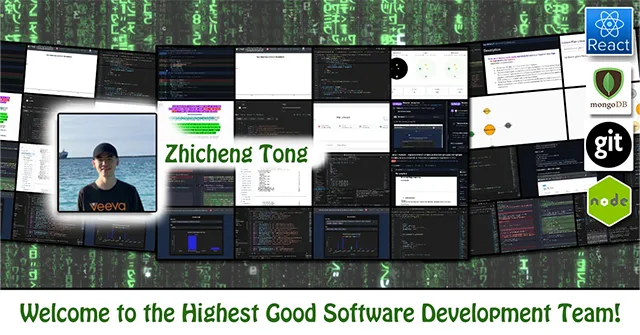
Zhicheng is a Master’s student in Electrical and Computer Engineering at the University of Illinois Urbana-Champaign and has experience in full-stack web development, data visualization, and scalable systems. He has demonstrated strong skills in both frontend and backend development, with a focus on performance, maintainability, and user experience. While a member of the One Community software team, Team Moonfall, Zhicheng contributed to the development of the Highest Good Network application by improving code sustainability and readability through refactoring frontend logic, optimizing data rendering with virtualization, and enhancing log visualization and filtering features to support efficient handling of large datasets.
WELCOME TO THE TEAM ZHICHENG!
FOLLOW ONE COMMUNITY’S PROGRESS (click icons for our pages)
INVESTOR PAGES
GET INVOLVED
One Community Welcomes Sudheesh Thuralkalmakki Dharmappa Gowda to the Software Development Team!
Posted on December 6, 2025 by One Community Hs
One Community welcomes Sudheesh Thuralkalmakki Dharmappa Gowda to the Software Team as our newest Volunteer/Consultant!
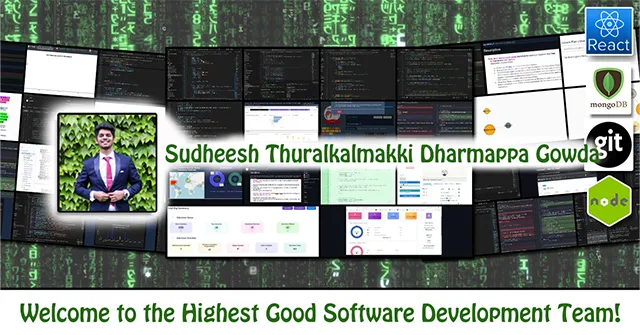
Sudheesh completed his Master of Science in Computer Science at the Illinois Institute of Technology. He has worked across multiple technology domains building scalable backend systems and secure full-stack applications. He believes in creating solutions that maximize performance and elevate user experience through meaningful technical design. As a member of the One Community team, Sudheesh contributes by setting up the Highest Good Network Phase 4 backend structure and its controllers, developing the Education Profile Page to display student details, building the Phase 2 Summary Dashboard to present materials utilization chart data, and adding column-specific tooltips to improve user guidance on the Daily Equipment Log page.
WELCOME TO THE TEAM SUDHEESH!
FOLLOW ONE COMMUNITY’S PROGRESS (click icons for our pages)
INVESTOR PAGES
GET INVOLVED
One Community Welcomes Abhiram Bylahalli Jagadish to the Software Development Team!
Posted on December 6, 2025 by One Community Hs
One Community welcomes Abhiram Bylahalli Jagadish to the Software Team as our newest Volunteer/Consultant!
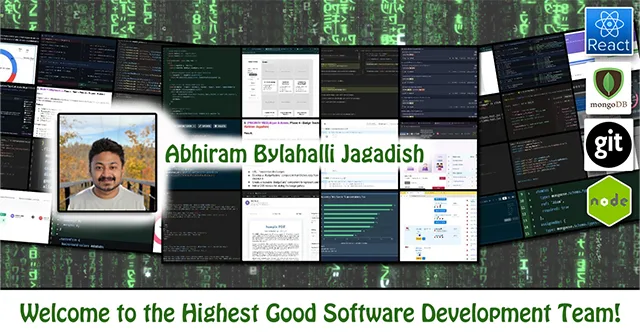
Abhiram is a full-stack software developer with experience in API design, React frontend development, and database management. He holds a degree from the Illinois Institute of Technology in Chicago. Skilled in JavaScript, Node.js, and MongoDB, he has a strong interest in technology trends, system design, and video editing. While a member of the One Community Software Team, he focused on backend and frontend development for the Highest Good Network application, implementing document review workflows, badge systems, and user submission interfaces. His contributions included developing page-specific feedback mechanisms, building educator comment systems for streamlined grading, and enhancing user submission tools to improve the review and assessment experience for both educators and students.
WELCOME TO THE TEAM ABHIRAM!
FOLLOW ONE COMMUNITY’S PROGRESS (click icons for our pages)
INVESTOR PAGES
GET INVOLVED
One Community Welcomes Malhar Y. Solanki to the Engineering Team!
Posted on December 5, 2025 by One Community Hs
One Community welcomes Malhar Y. Solanki to the Engineering Team as our newest Volunteer/Consultant!
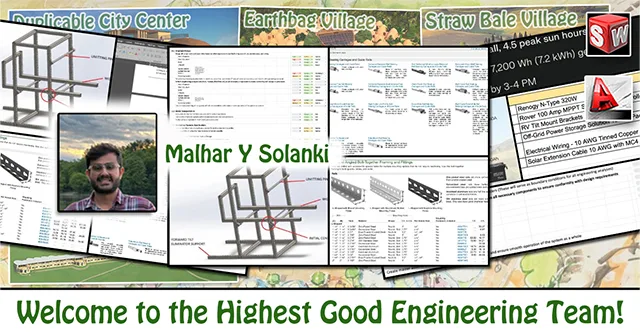
Malhar brings 2 years of experience in FMCG, manufacturing, and construction project management. Known for a detail-oriented and quality-driven approach, he emphasizes consistent improvement, precision, and practical solutions that enhance product reliability and operational efficiency. He values clear processes and effective communication as key factors in delivering successful projects on time and within scope. As a member of the One Community team, Malhar has contributed to developing Bills of Materials (BOM), creating SOPs and technical documentation, and managing the vermiculture toilet project, ensuring the sustainable and efficient completion of these eco-friendly sanitation solutions.
WELCOME TO THE TEAM MALHAR!
FOLLOW ONE COMMUNITY’S PROGRESS (click icons for our pages)
INVESTOR PAGES
GET INVOLVED
One Community Welcomes Ajay Adithiya Kumar Elancheliyan Tamilalagi to the Engineering Team!
Posted on December 5, 2025 by One Community Hs
One Community welcomes Ajay Adithiya Kumar Elancheliyan Tamilalagi to the Engineering Team as our newest Volunteer/Consultant!
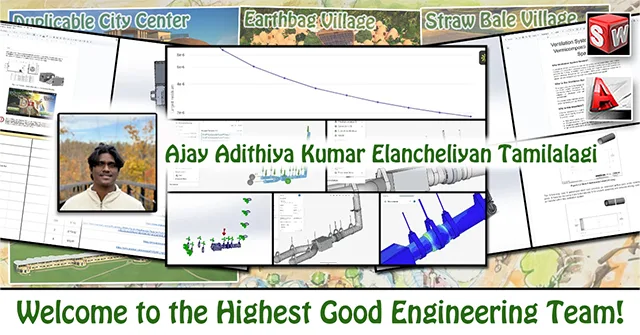
Ajay is a Mechanical Engineer with around 3 years of combined experience across engineering projects. He has worked on advanced automotive systems, EV battery component optimization, HVAC design, lattice heat-sink R&D, and mechanical prototyping using tools such as SolidWorks and CATIA. Ajay is passionate about creating efficient, reliable, and sustainable engineering solutions that integrate performance, manufacturability, and real-world application. As a member of the One Community Engineering Team, Ajay has contributed to the ventilation system design for the vermiculture eco-toilet system, completing FEA and CFD validation, material selection, updated CAD assemblies, an optimized BOM, design revisions, and collaboration toward the project’s final documentation and development.
WELCOME TO THE TEAM AJAY!
FOLLOW ONE COMMUNITY’S PROGRESS (click icons for our pages)
 One Community
One Community
